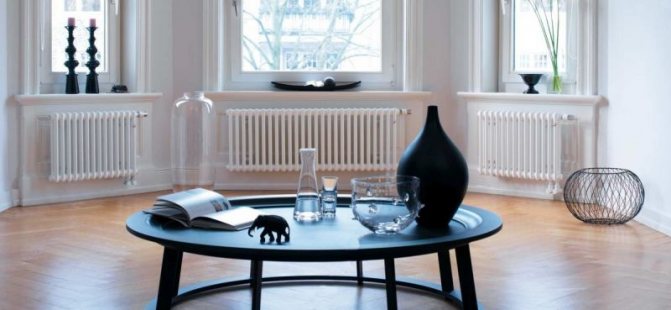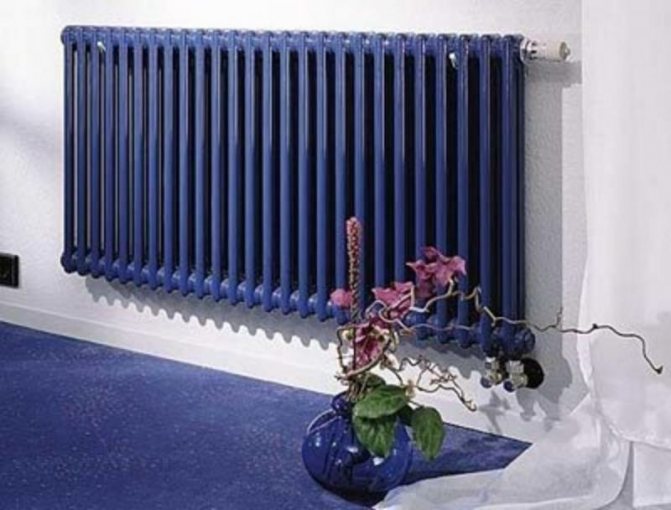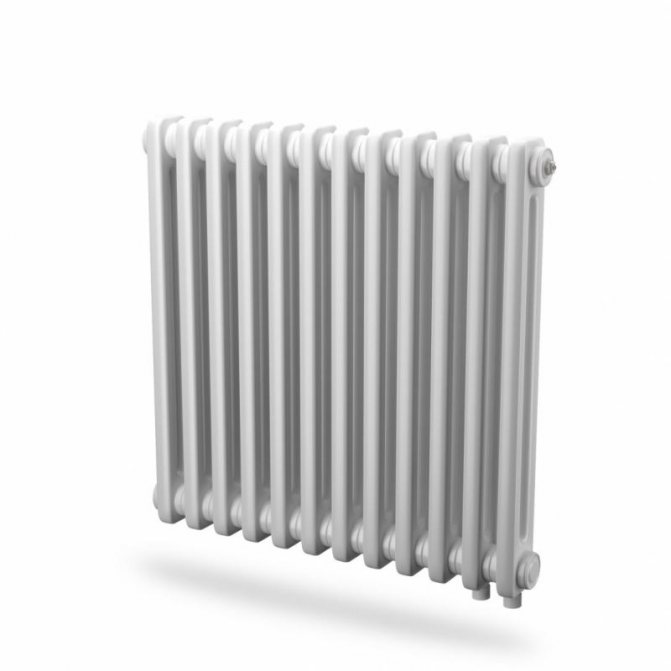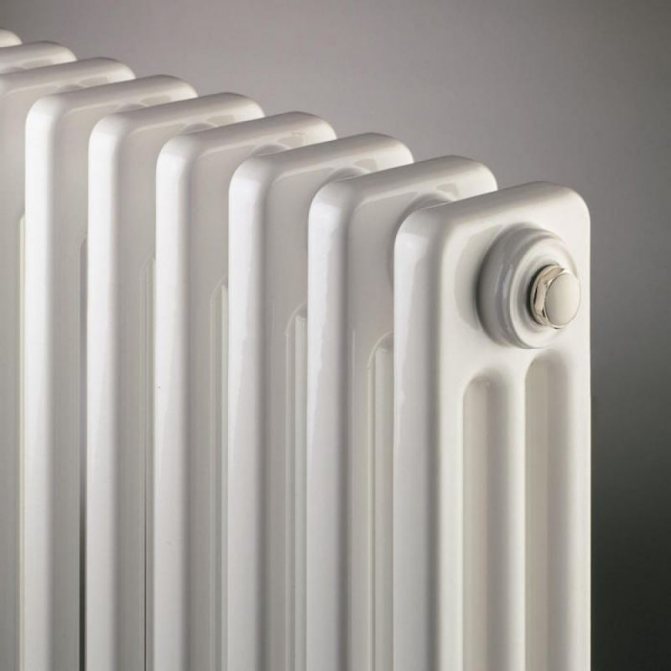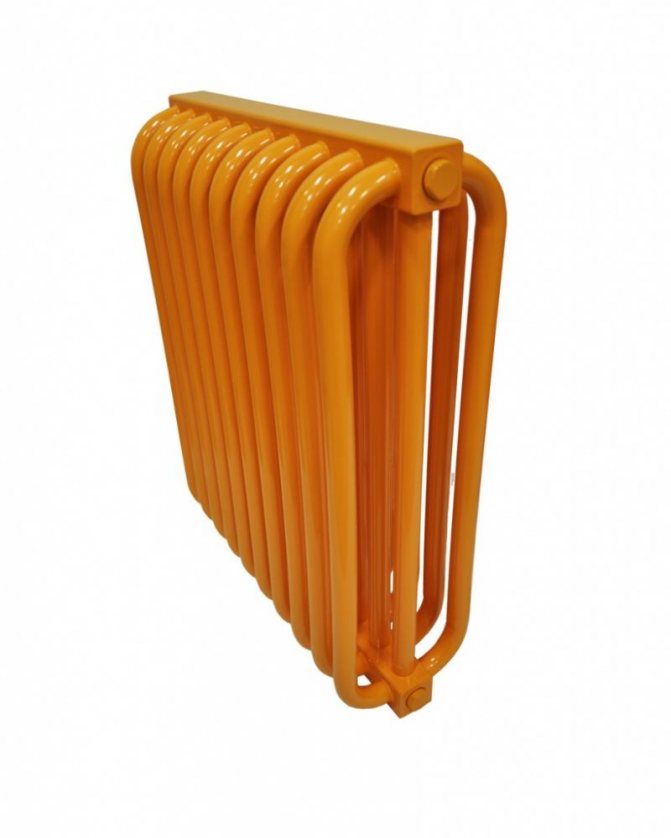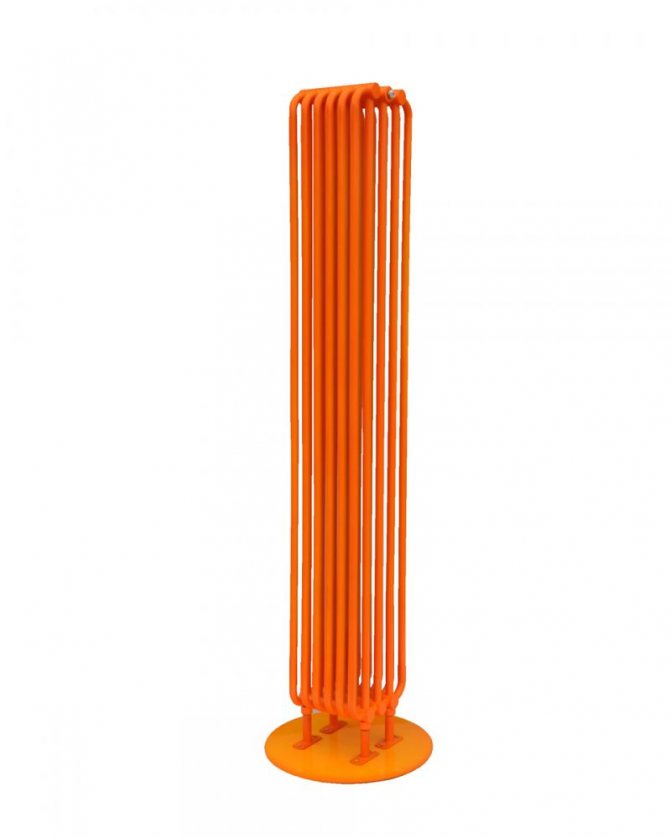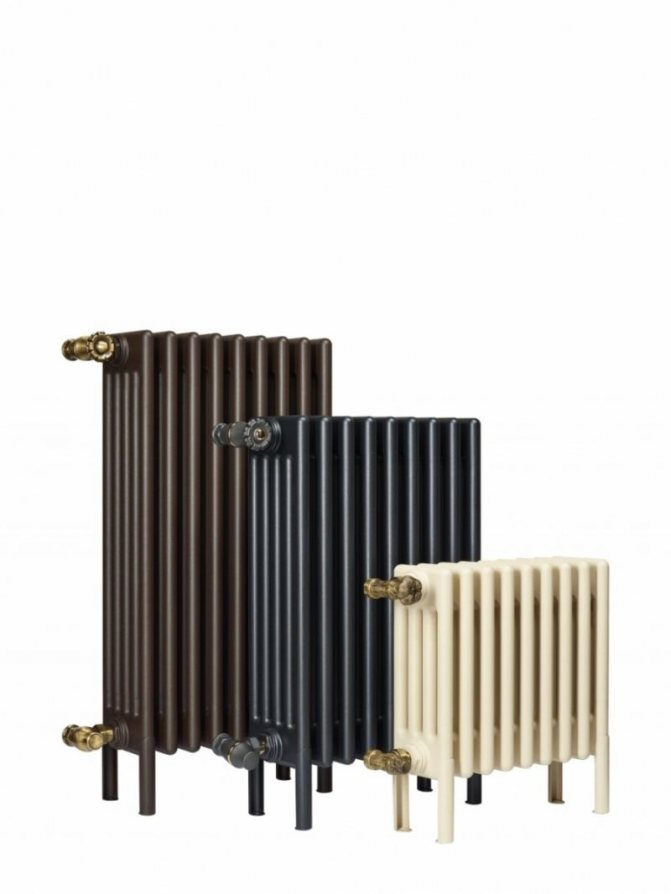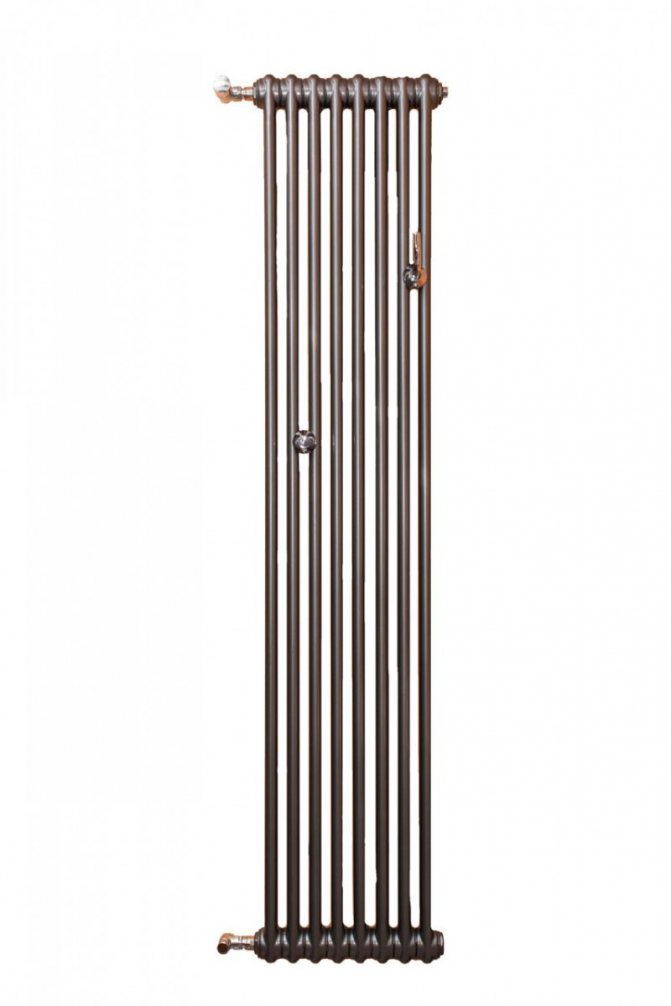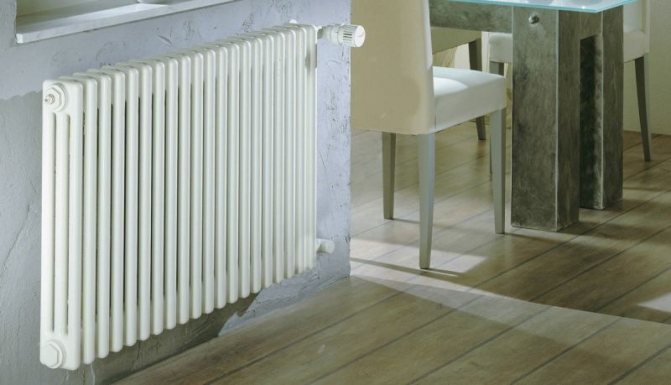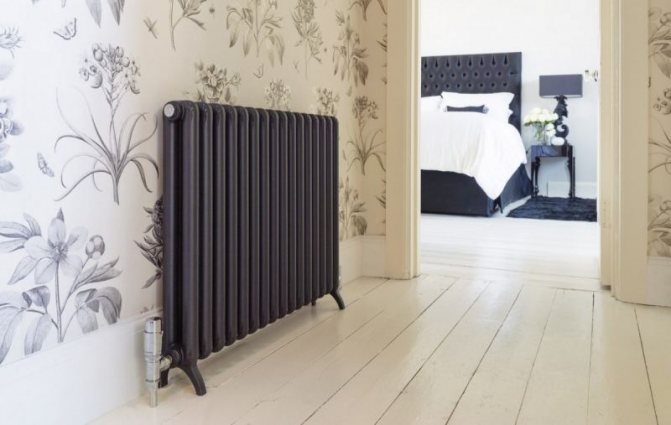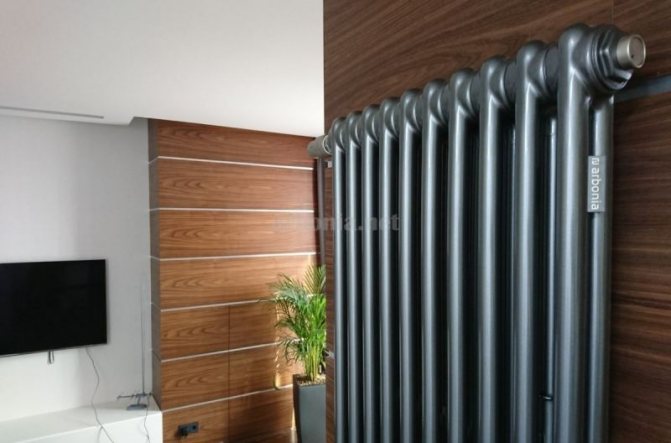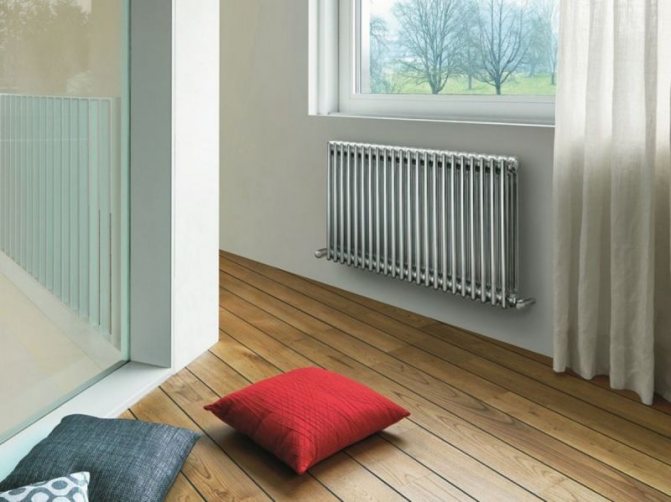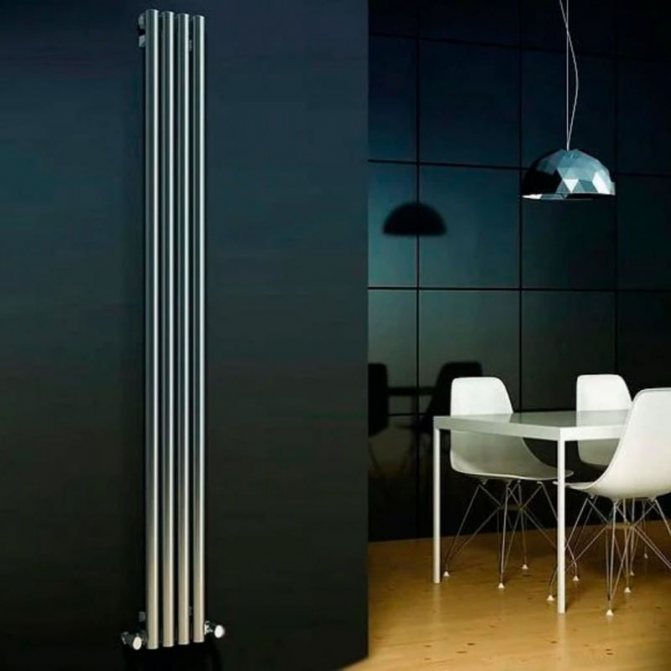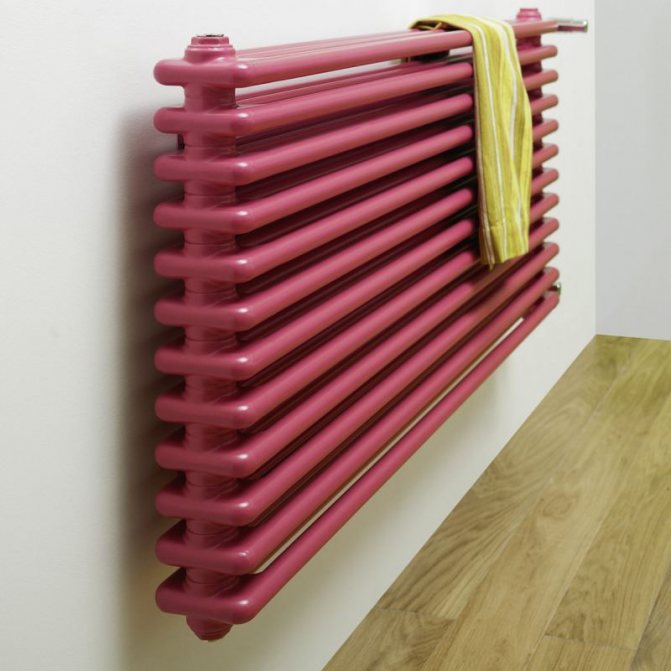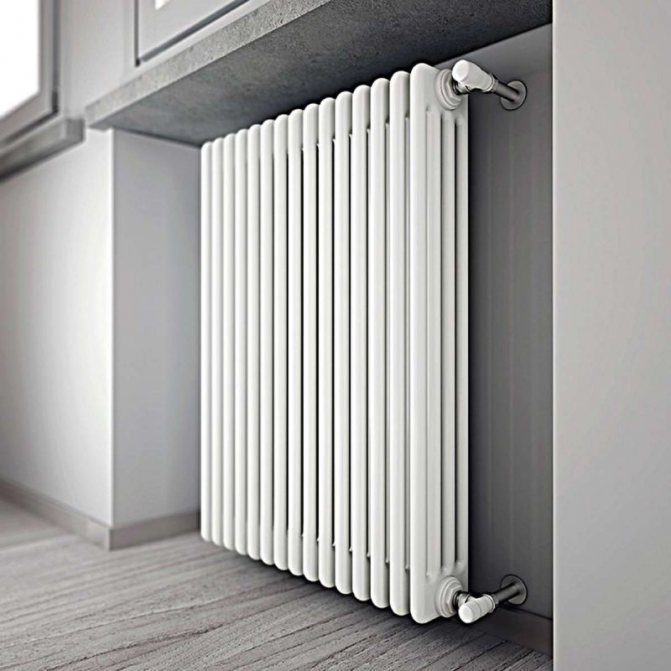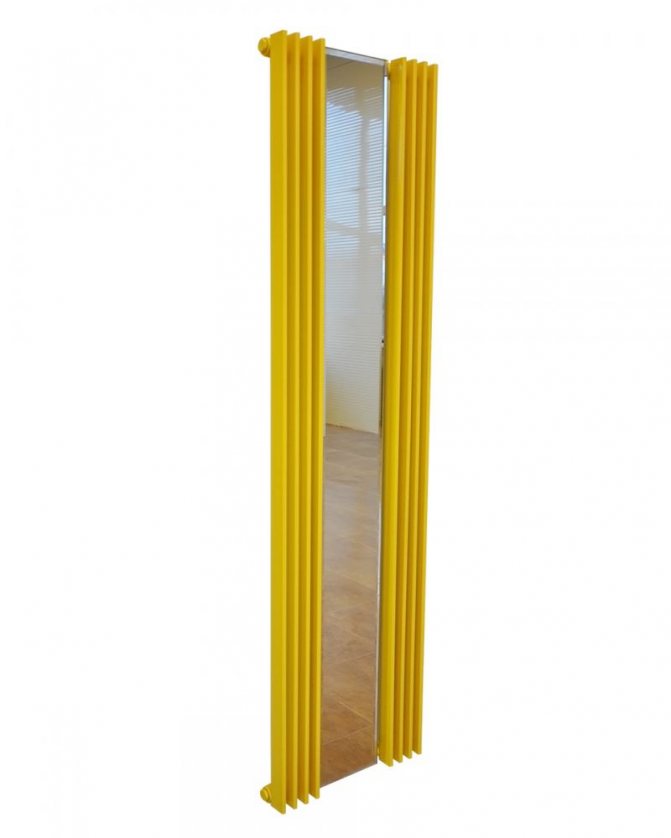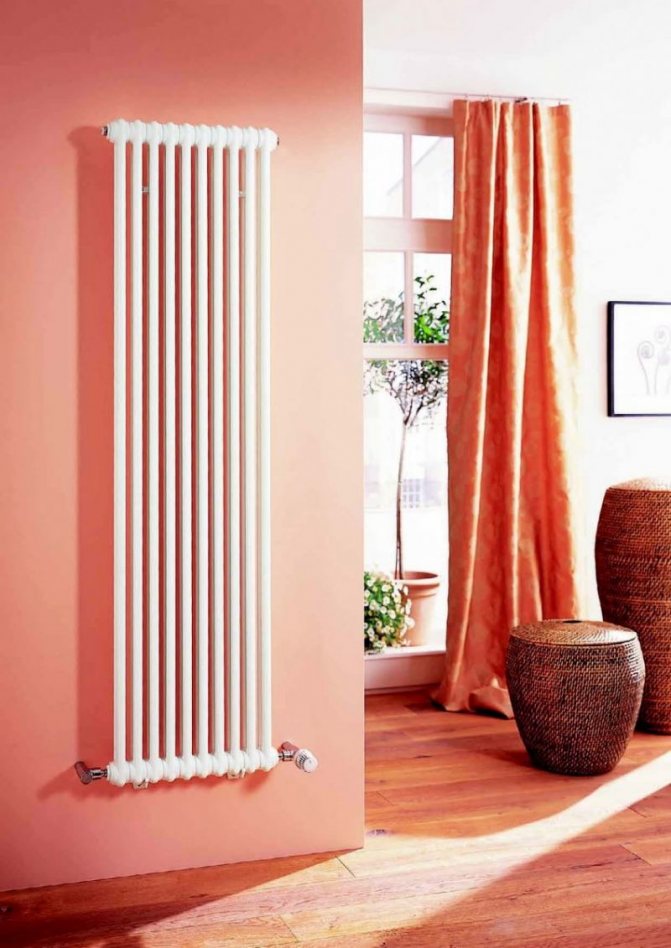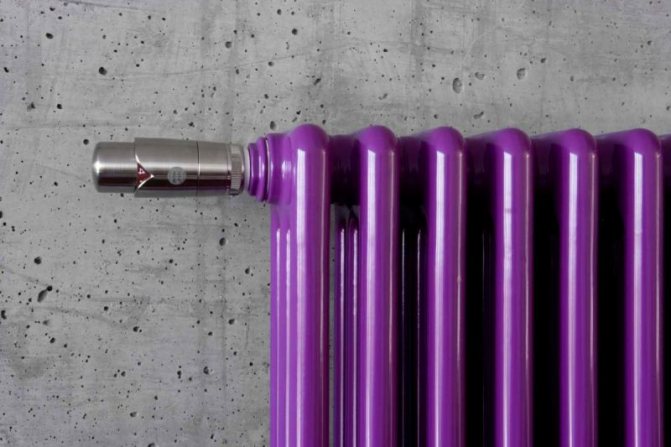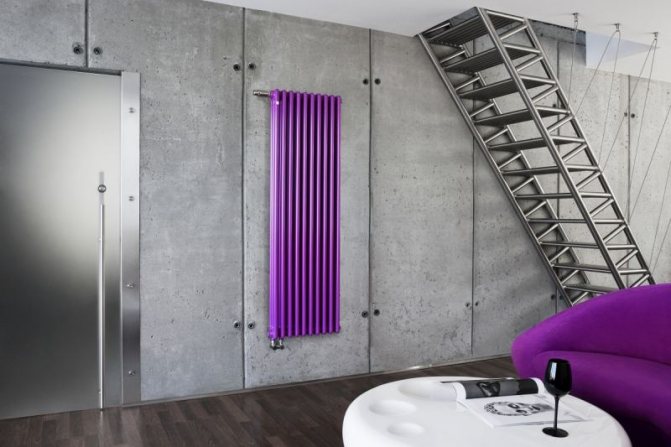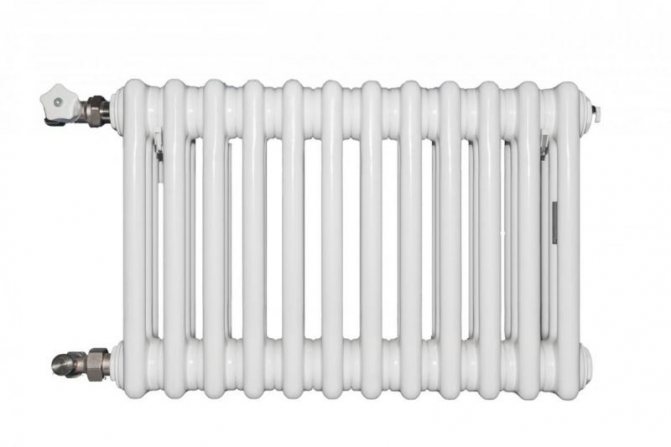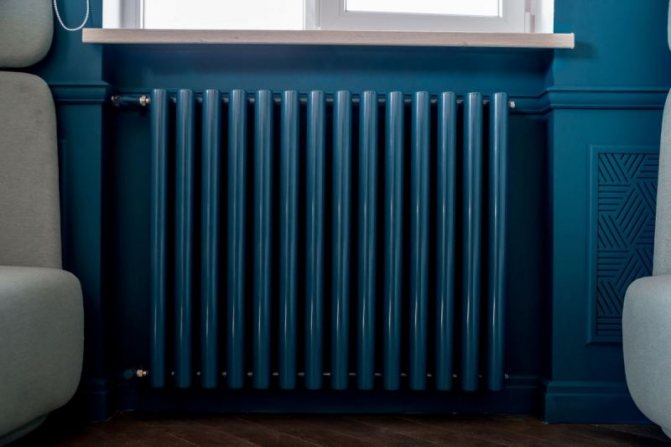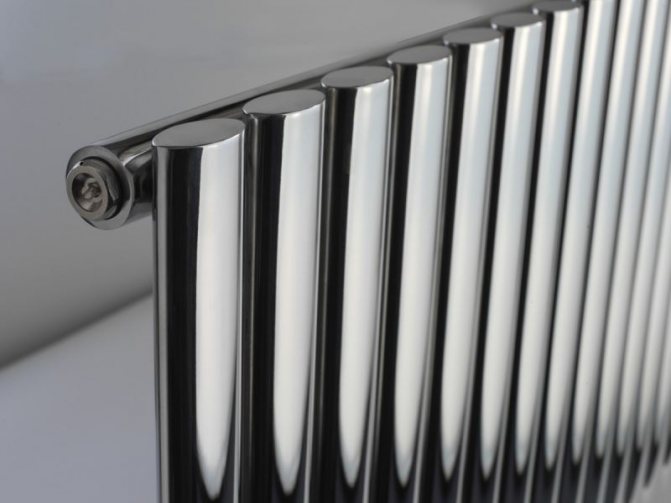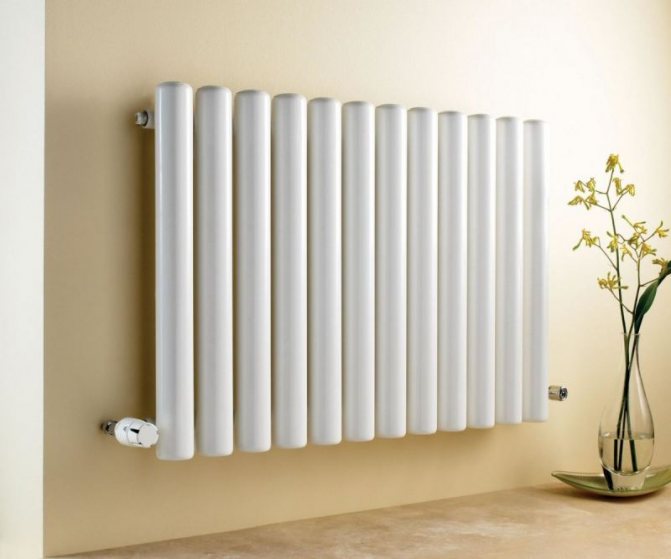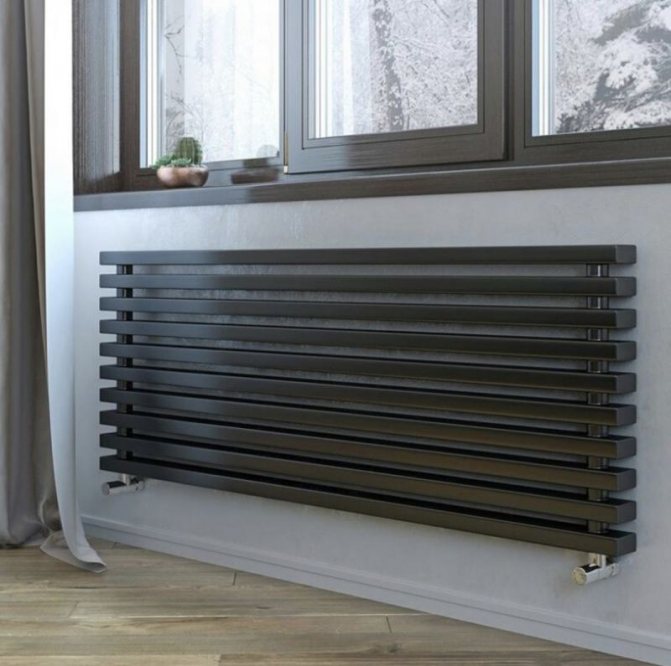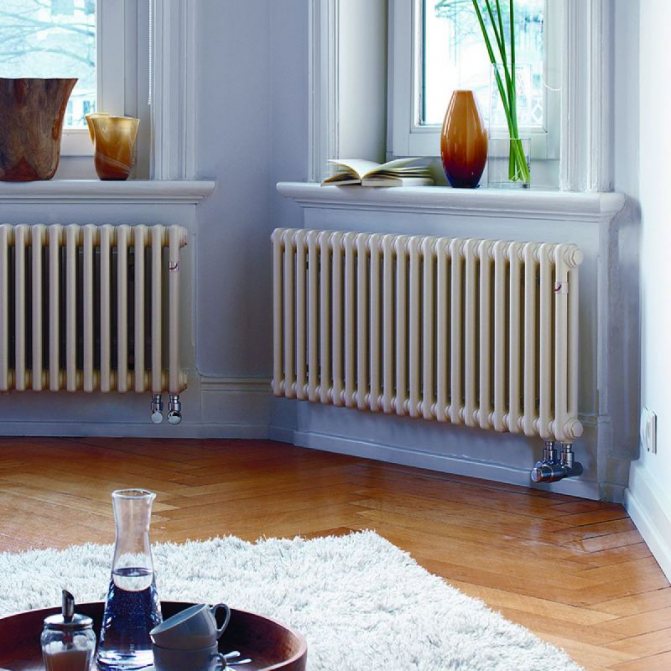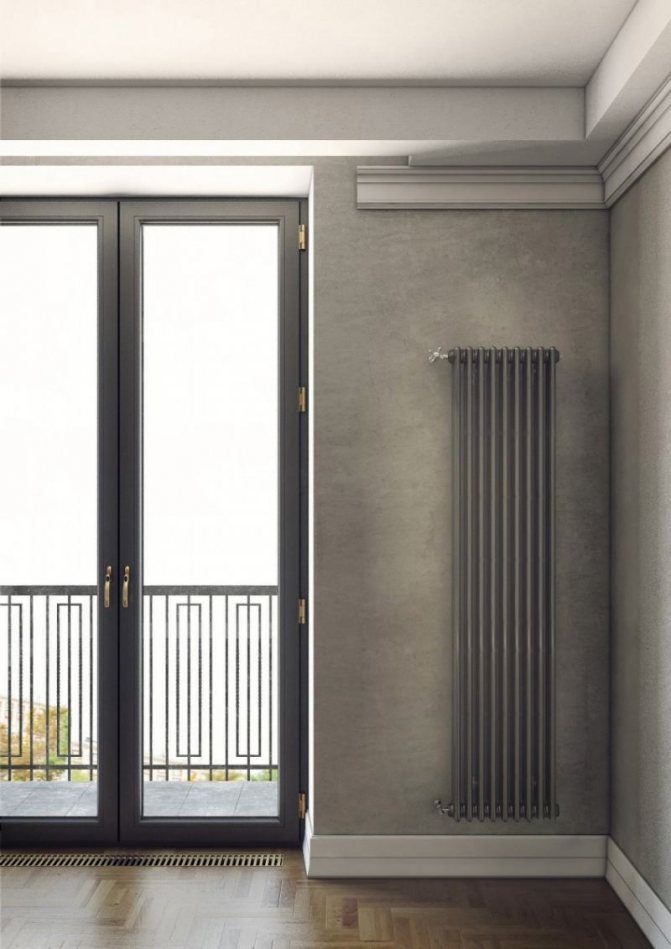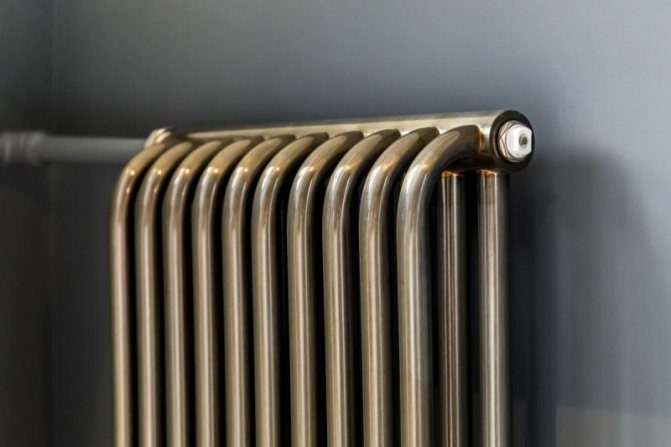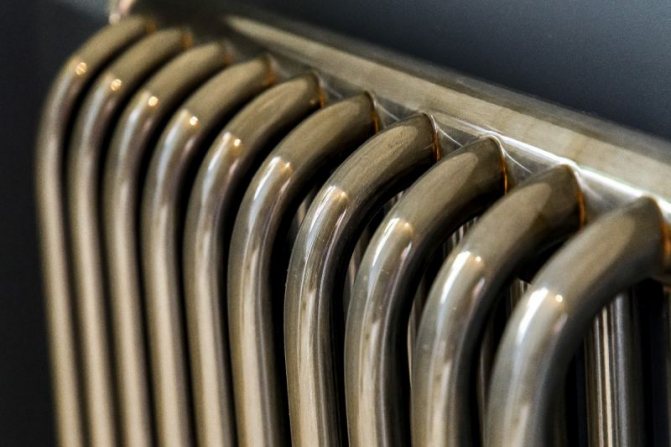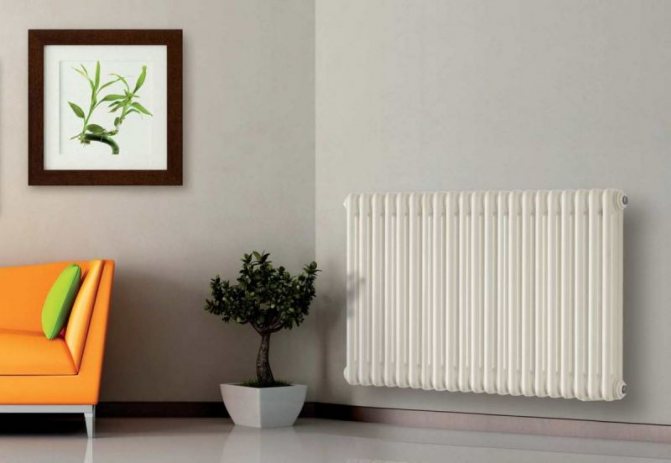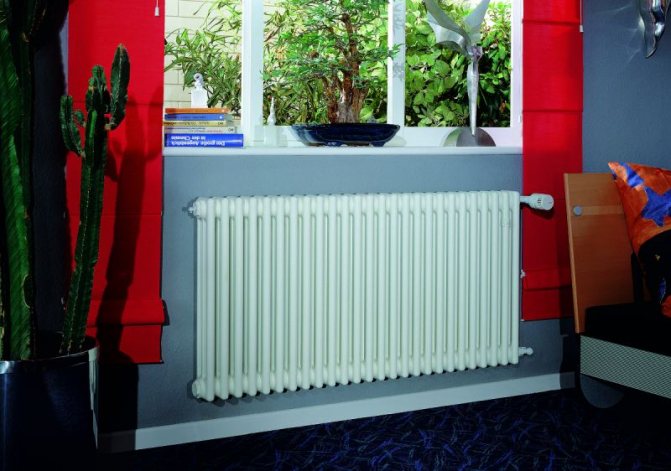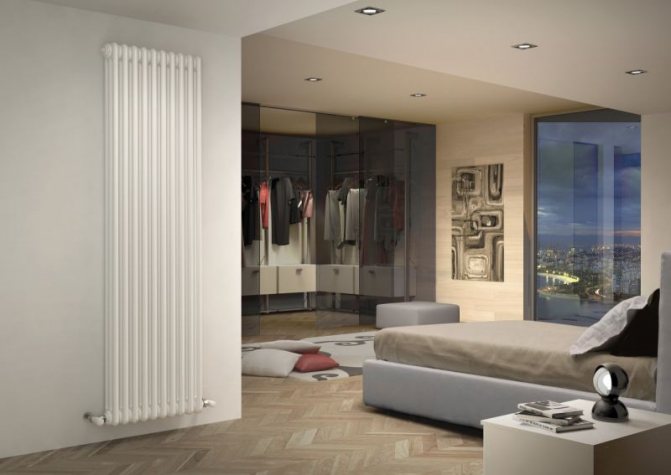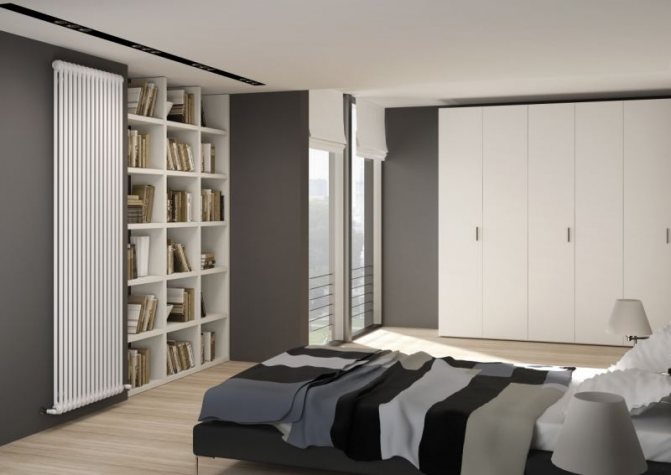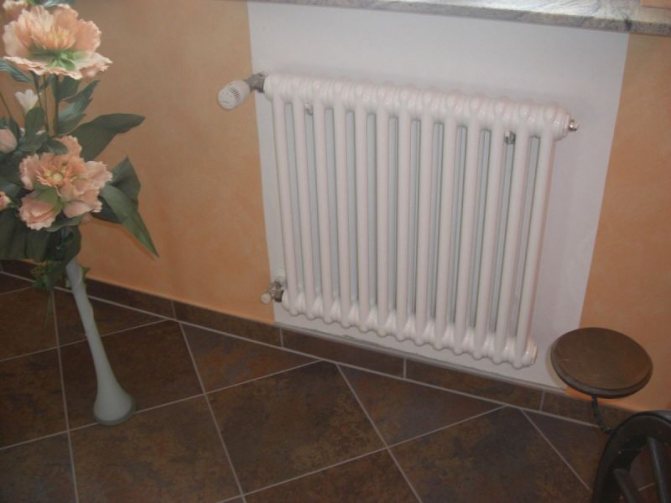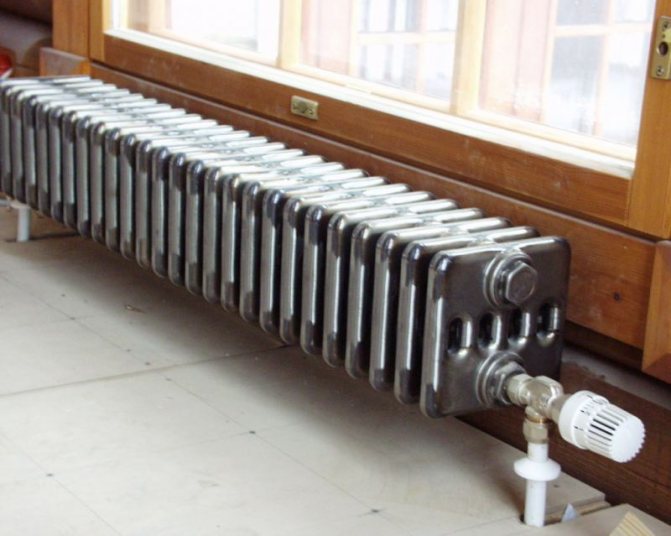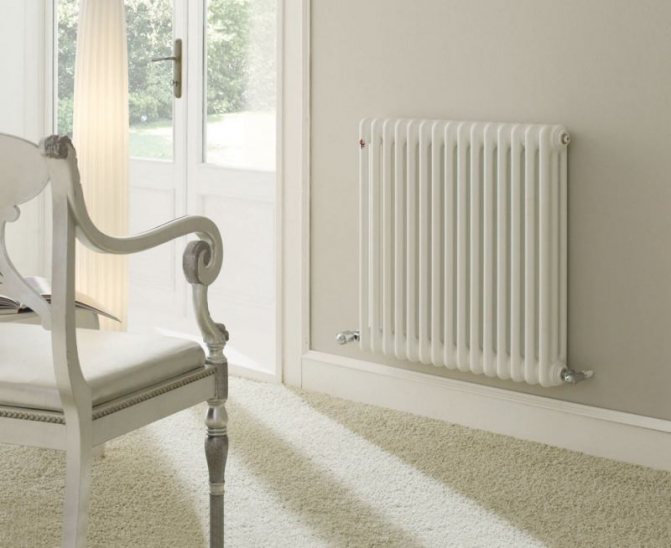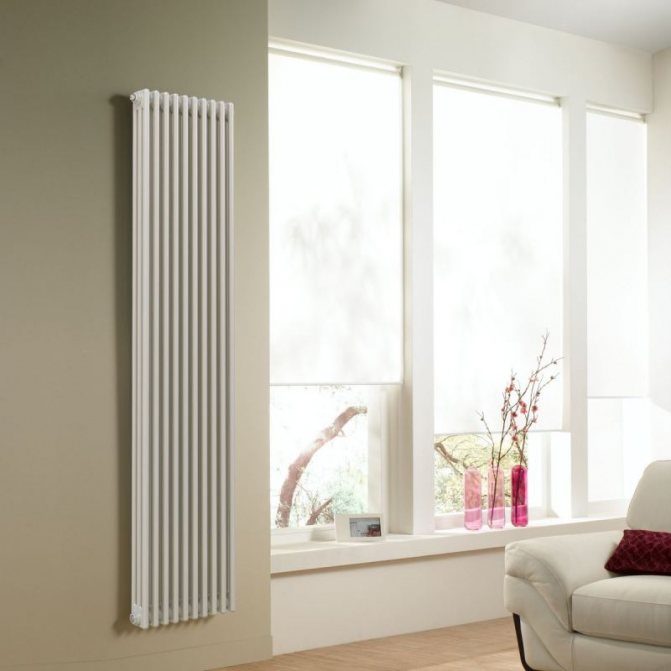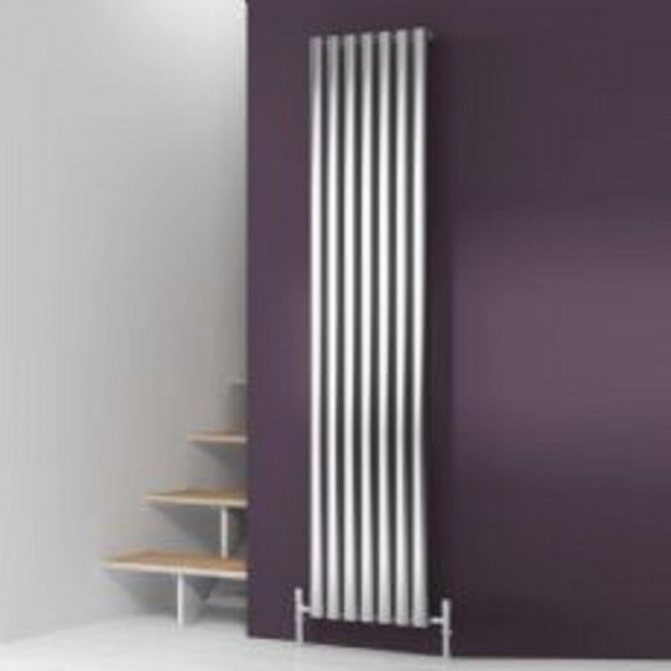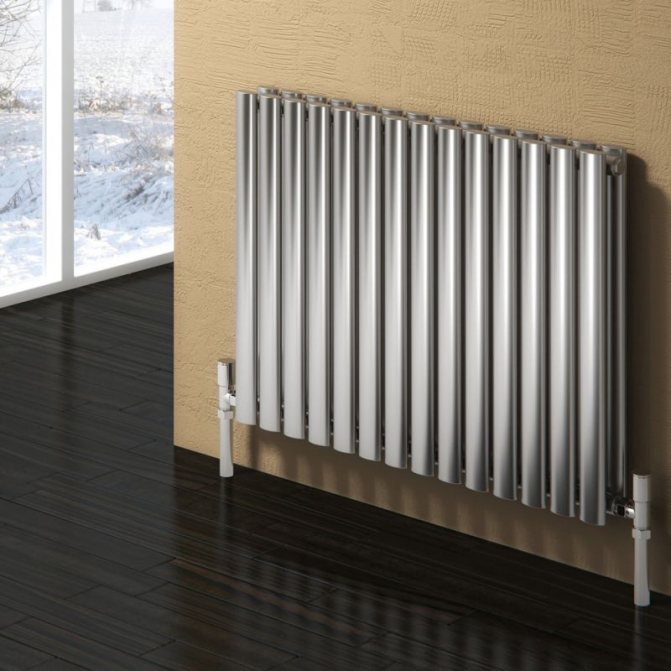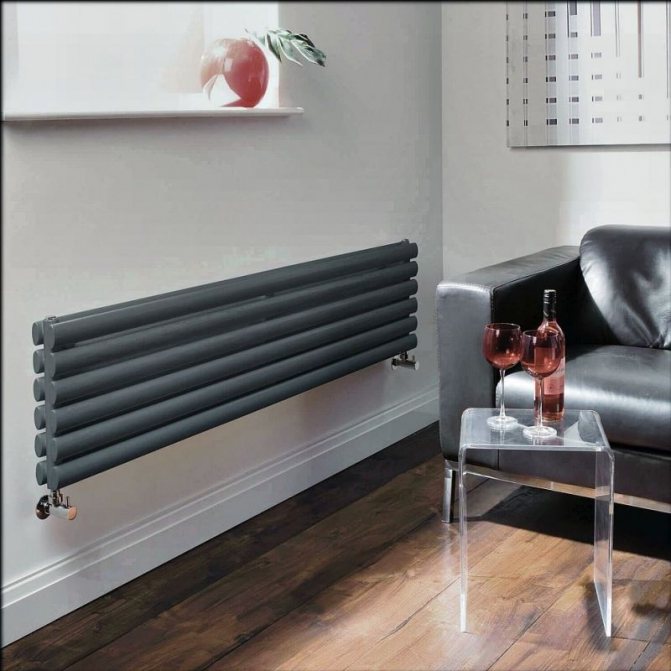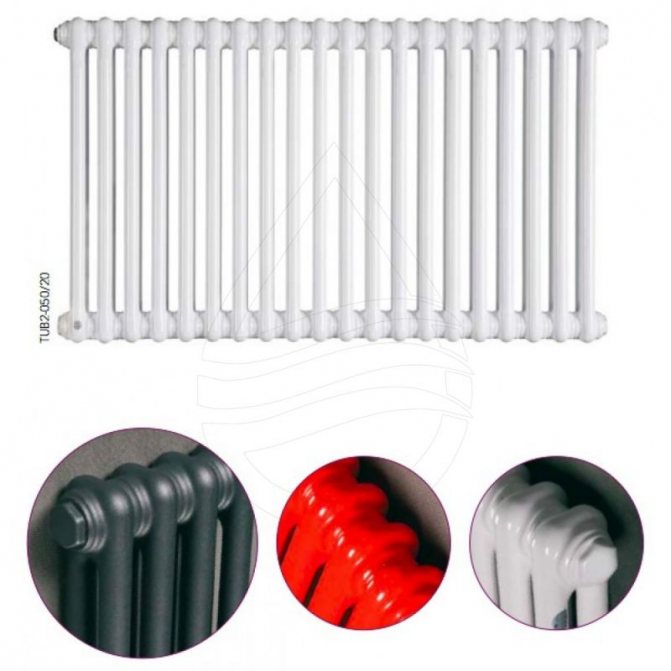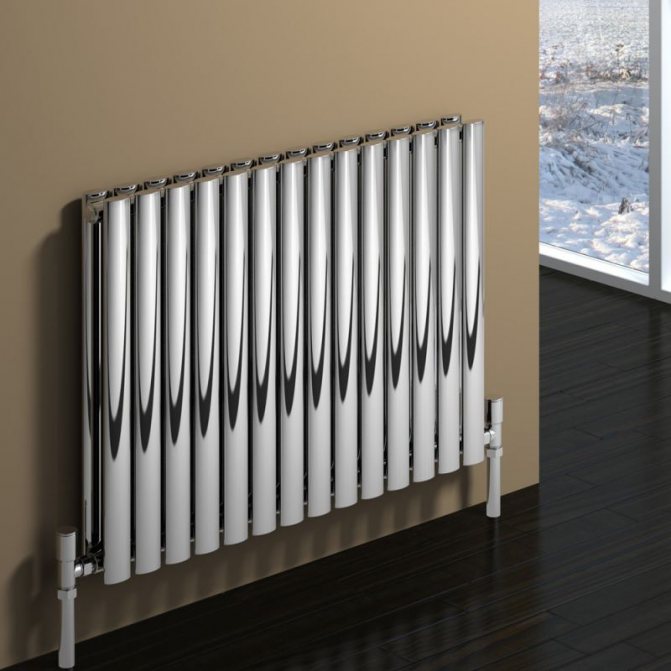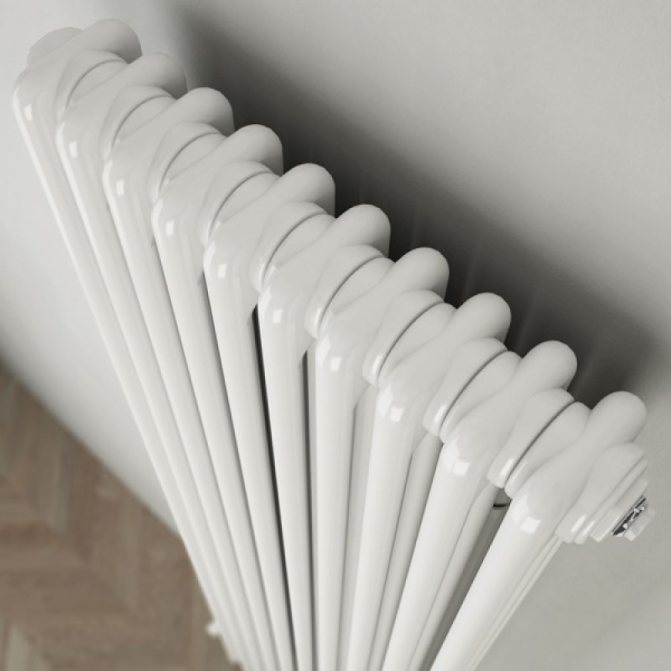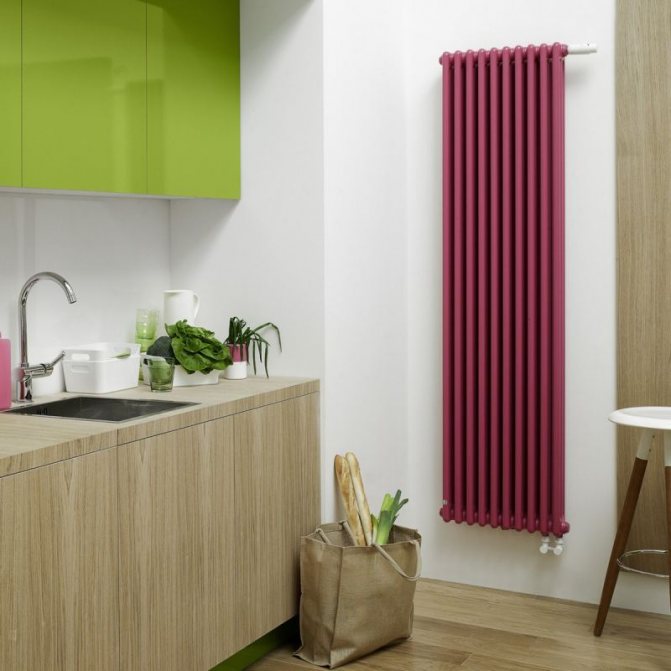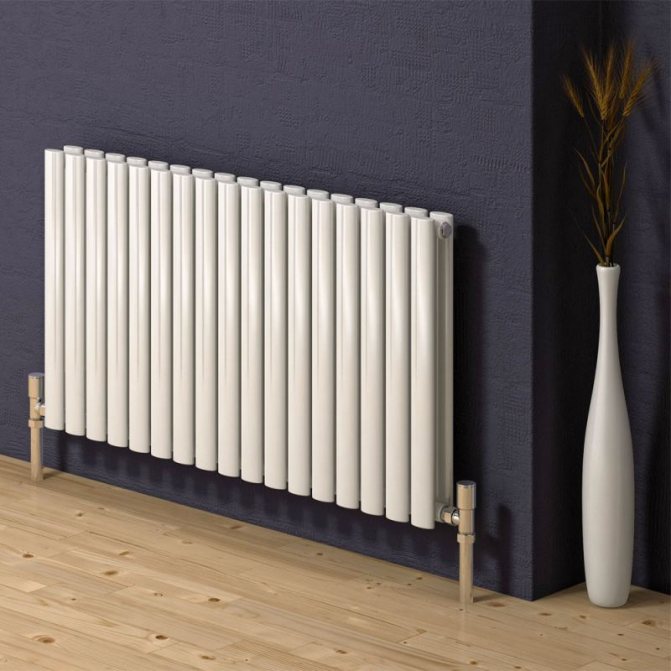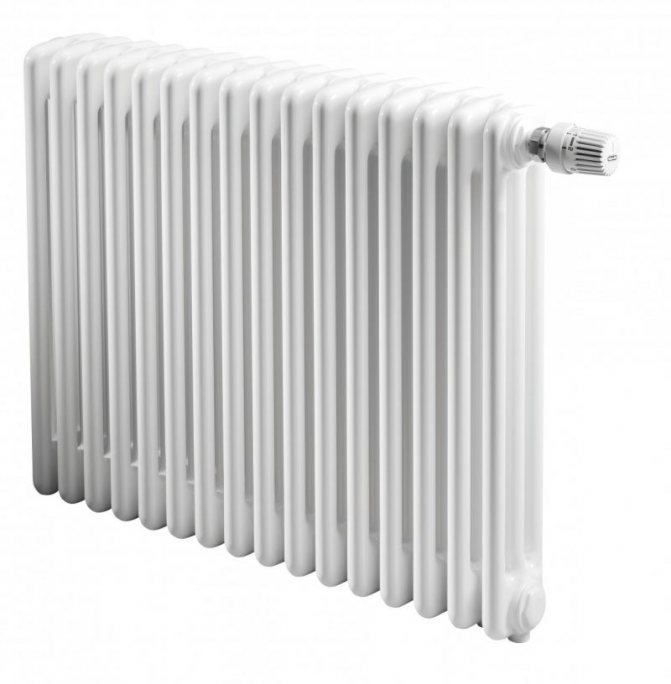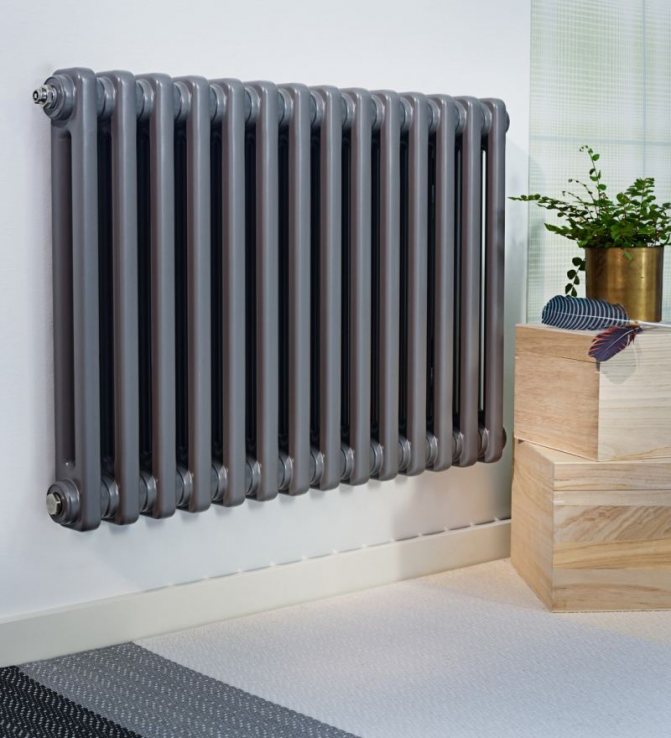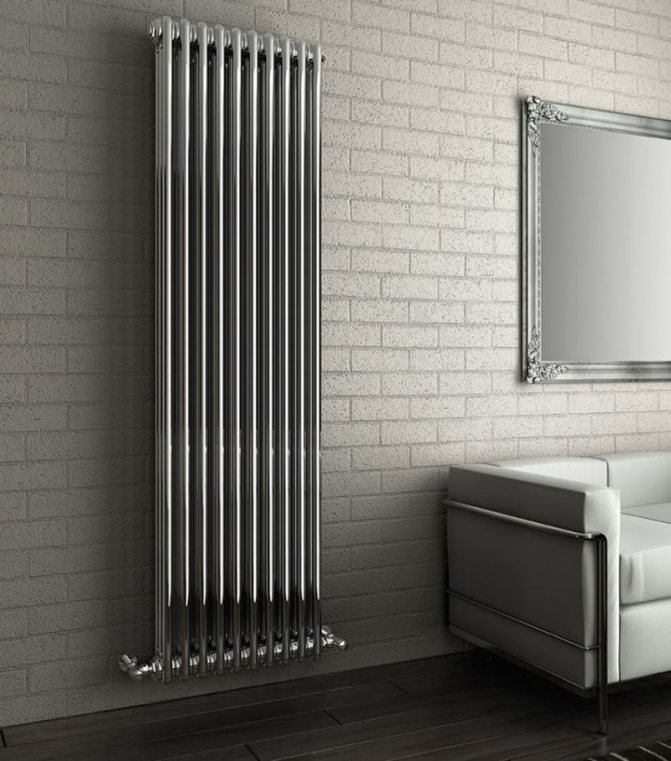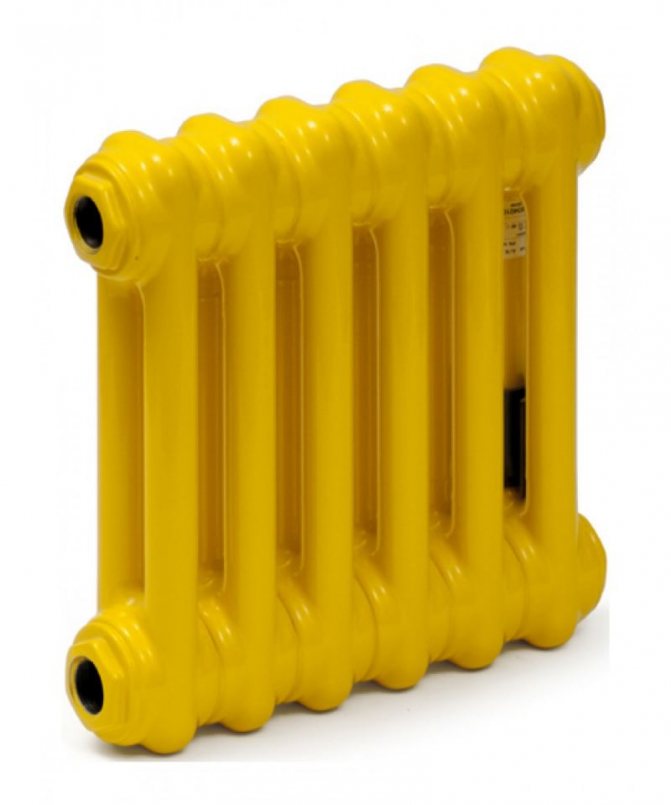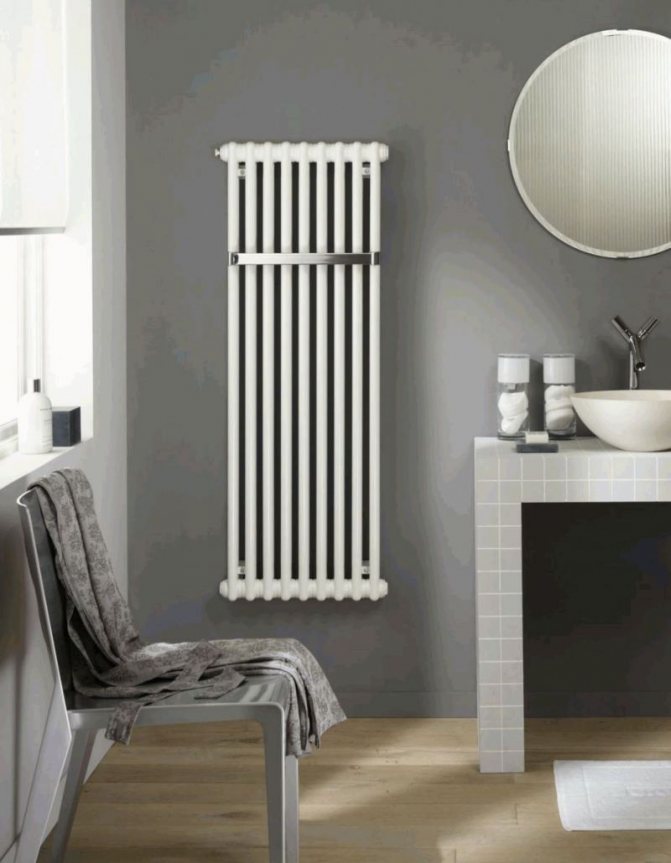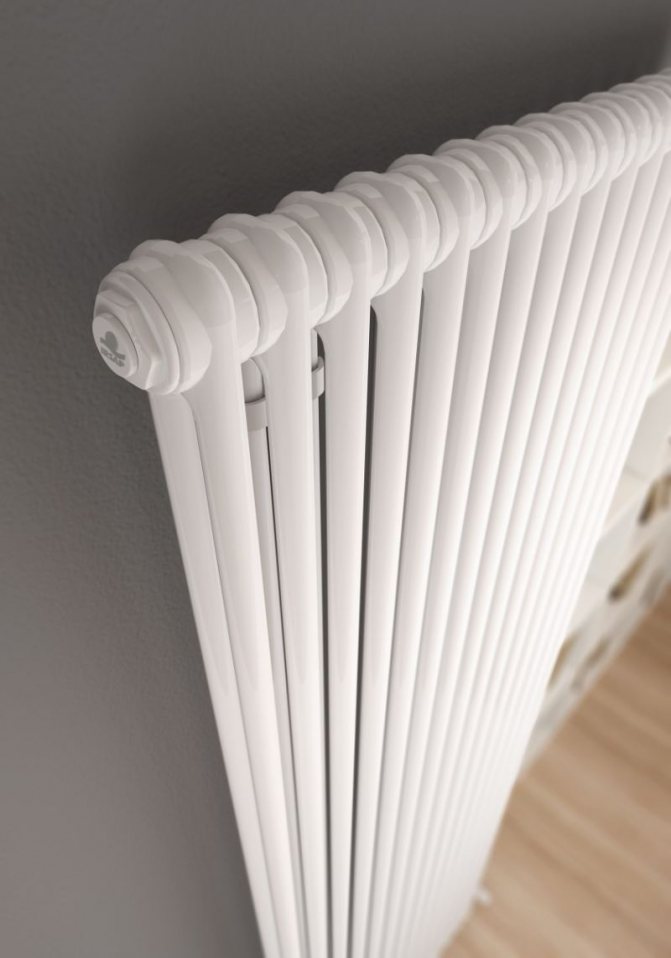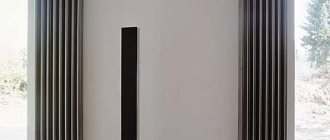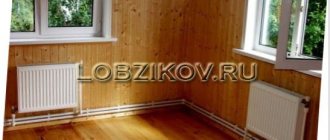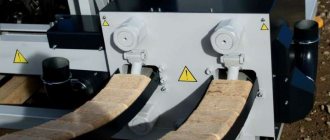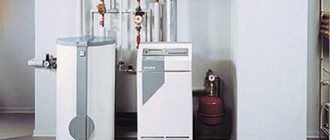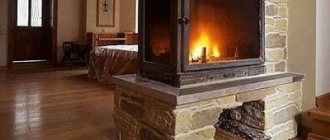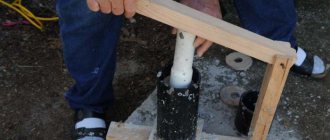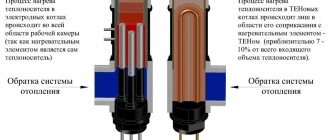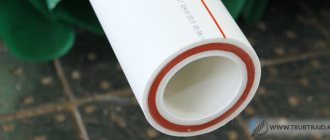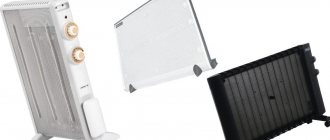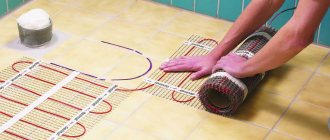Rank: 351

In winter, all apartments and houses definitely need good heating, the choice of radiators for heating homes is always difficult when the market is abundant. Why not stop your gaze and look at tubular heating radiators, which in appearance resemble an accordion.
A number of steel tubes are connected together, suspended from the wall. The air from their use in the room is not dry, that is, they do not violate the humidity regime. Tubular radiators for heating are durable, reliable, and if used correctly, they will last a long time. They are recommended to be used in private houses; they are not suitable for high-rise buildings.
Tubular radiator design
Unlike the old cast iron versions of tubular batteries, modern designs are much prettier and better executed. They represent two functional compartments: upper and lower.


These compartments are interconnected by special steel pipes. Tubular steel radiators of modern models look very tiny and pretty.
In addition, all joints on them are extremely safe and are laser welded seams. Such a seam is very difficult to damage, which allows the batteries to be more durable.
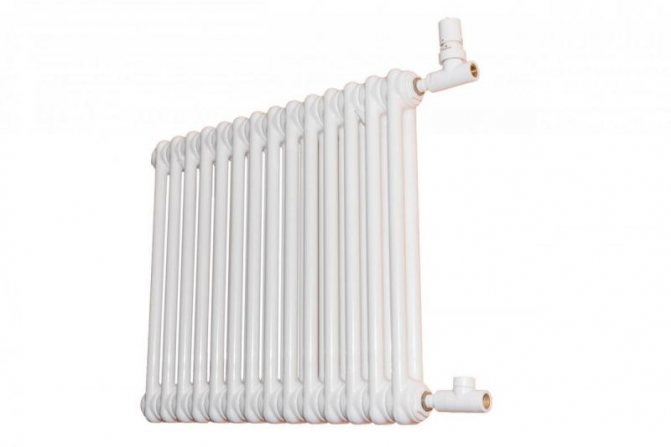

Despite their strength, steel tubular radiators are not able to withstand large pressure drops. For this reason, their installation is recommended only in private houses or apartments of five-story buildings.
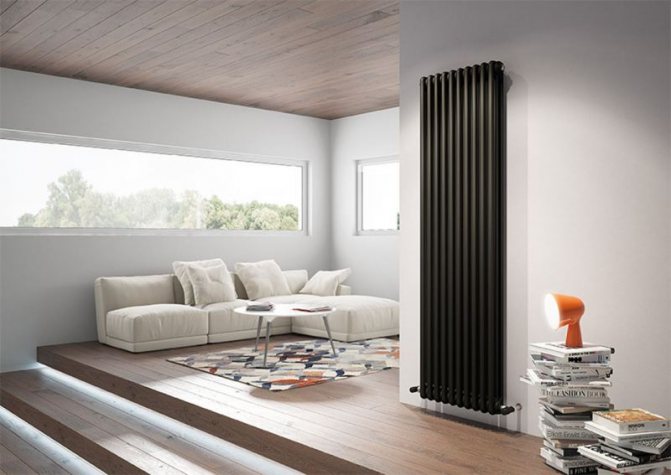

In high-rise buildings, there are often unforeseen power surges that exceed 10 atmospheres.
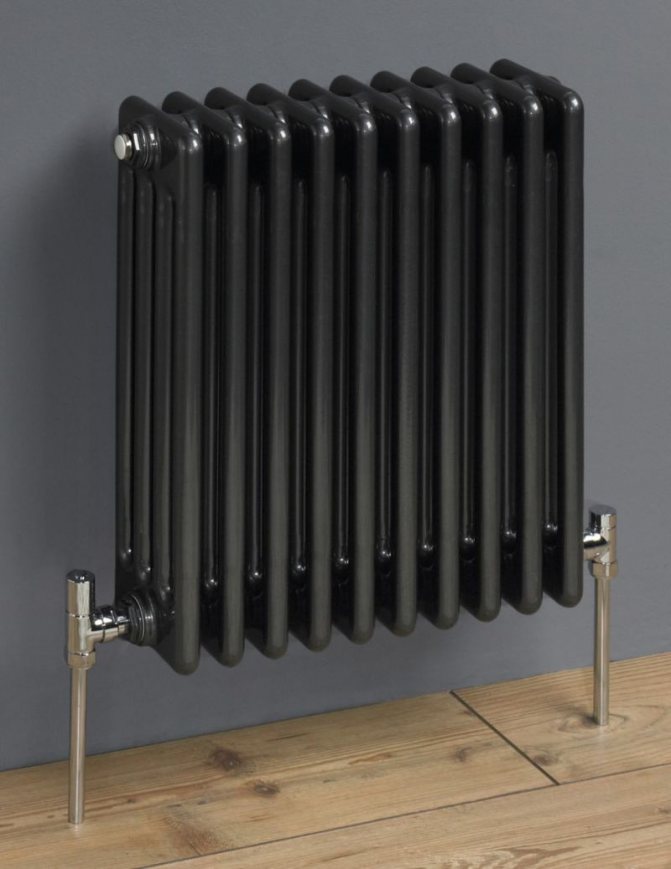

Tubular steel radiators are very popular in medical institutions. This is easy to explain, since tubular batteries do not contain any corners that could cause injury.
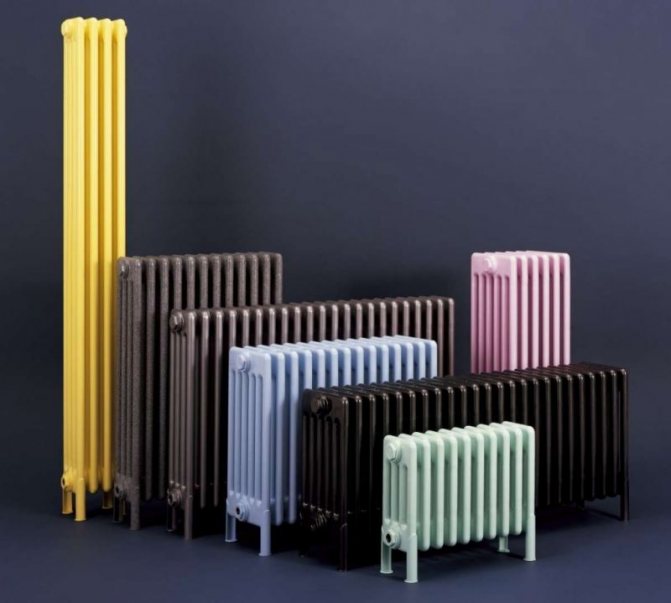

In addition, tubular radiators do not attract dust and do not require special cleaning. For hospital and outpatient institutions, these qualities are most important.
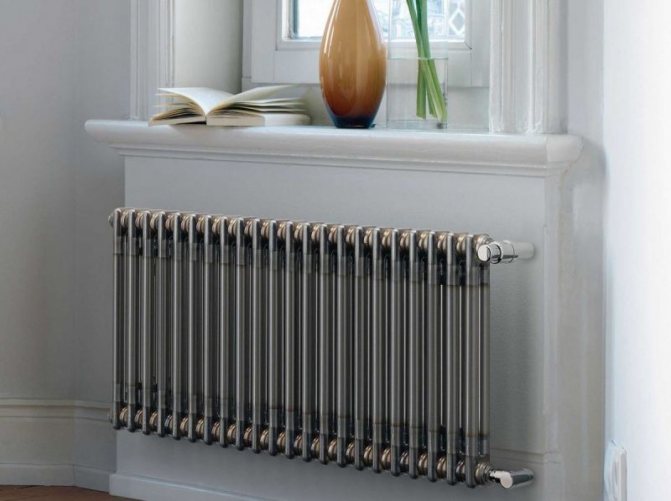

History and features
Tubular batteries were born in 1930 thanks to the master Robert Zender. He took the cooling system of the then motorcycles as a basis. After a small improvement, it became possible to use it for heating residential and industrial premises.
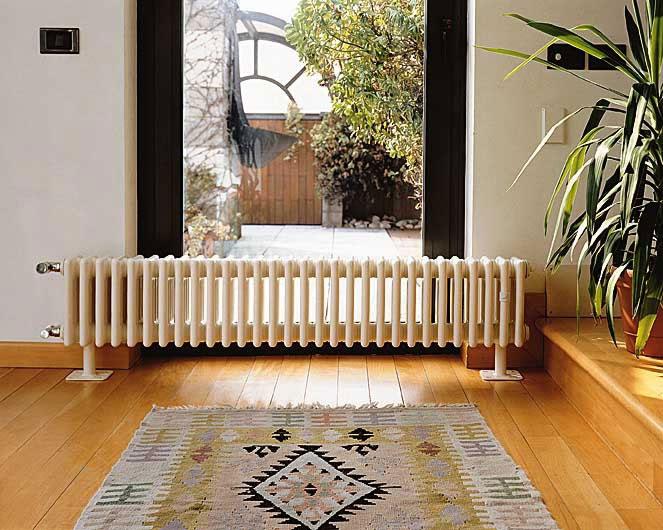

Tubular radiators today are a non-separable structure, which consists of a number of vertical tube-sections. For effective circulation of the coolant, the elements are connected by collectors at the top and bottom.
The heat transfer coefficient of the device depends on the number of tubes and their cross section. Steel products are in the greatest demand.
Profile stores offer a wide range of models of domestic and foreign production. Their height starts from 30 cm and reaches 3 meters (!). The number of tubes in a row ranges from 1 to 6.
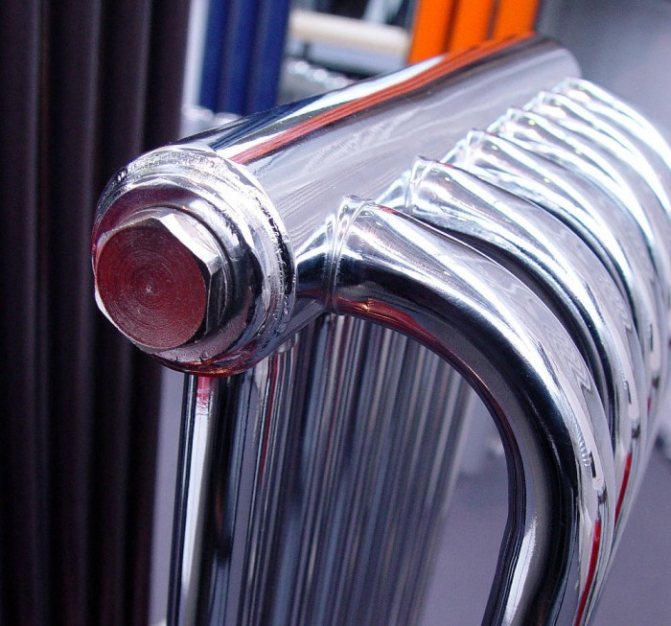

As for the pipe wall thickness, attention should be paid to the features of its standardization. Russian manufacturers adhere to the value of 1.5 mm, while this parameter may vary for foreigners. At the same time, our device can withstand a pressure 2 times more than a foreign one - 22 atmospheres versus 11-15.
Differences between tubular systems
Radiators of any shape have a special subdivision into types depending on various factors. Tubular can also have several possible variations.
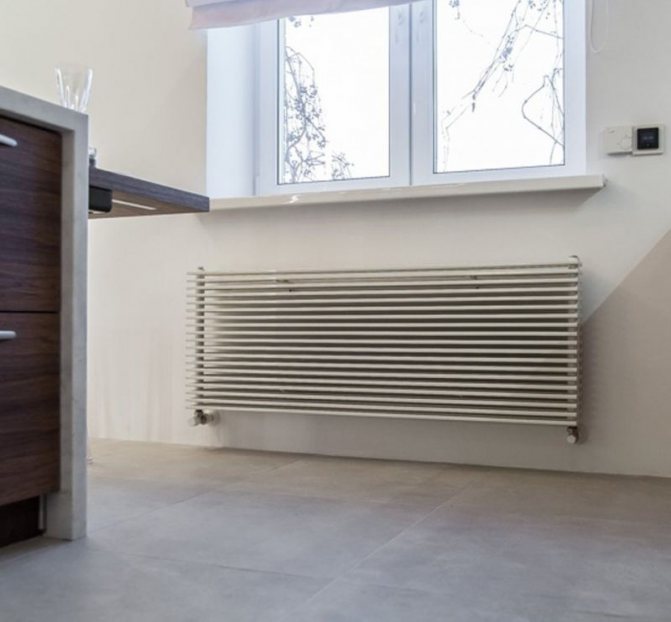

The largest separation is depending on the appearance of the device, namely, on the location of the pipes. These can be vertical and horizontal tubular heating radiators.
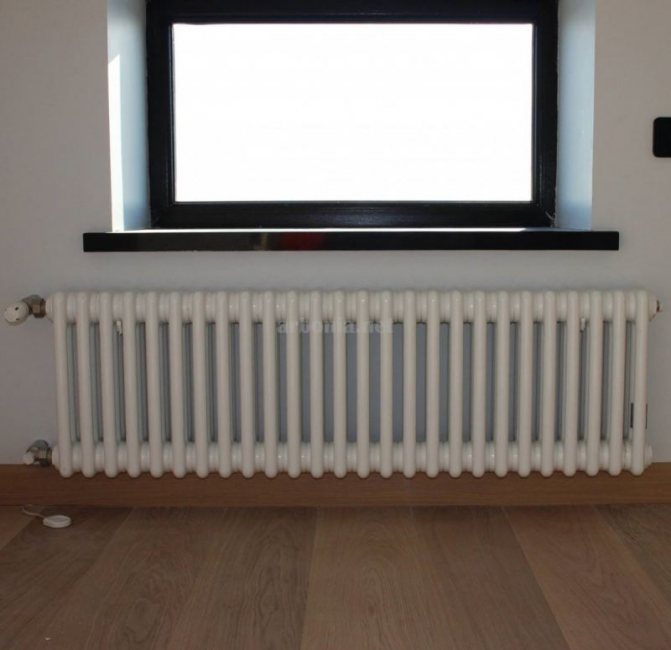

The first version of tubular radiators is the classic choice for private homes and medical institutions. They look beautiful, neat and do not accumulate dust on themselves.
But the second type - horizontal - is the choice for large office premises, where it is necessary to heat large areas.
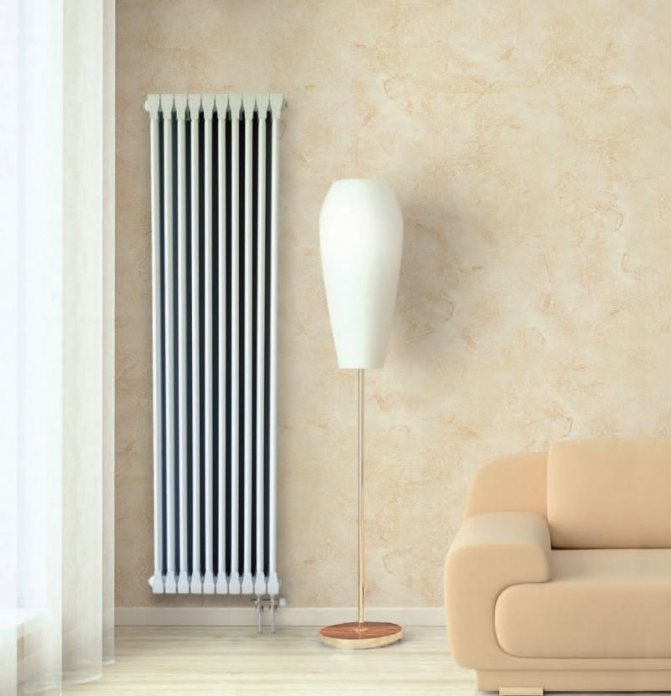

Due to the peculiarities of the shape, there are no frames when choosing tubular radiators. These can be models for an angular arrangement, and simple flat ones, and any design ones.
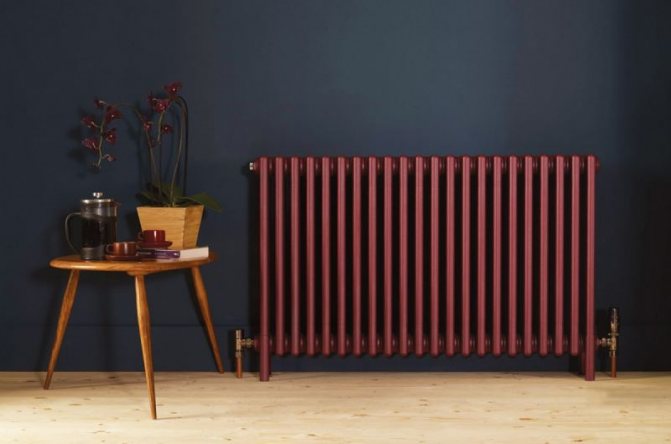

- Cast iron heating radiators: description of the best models, installation and characteristics of radiators (120 photos)

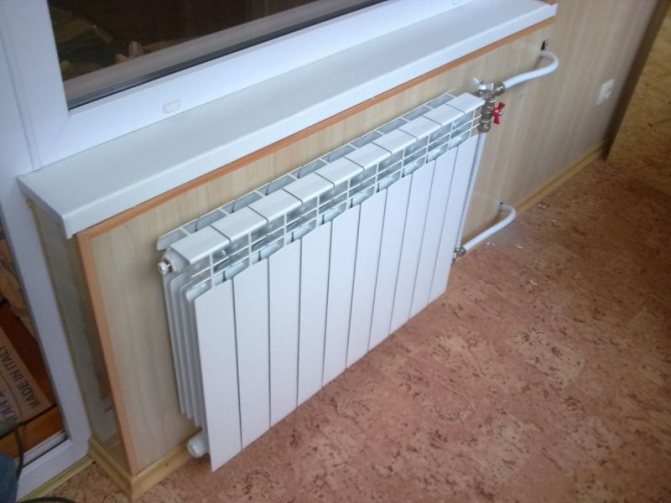
Flushing heating radiators: purging, cleaning and maintaining the heating system (115 photos)
- Gas convectors - choice, features of use and owner reviews (video + 105 photos)
Most often, people choose just ordinary options, but in some cases they are made to order in the form that is closer to the homeowners.
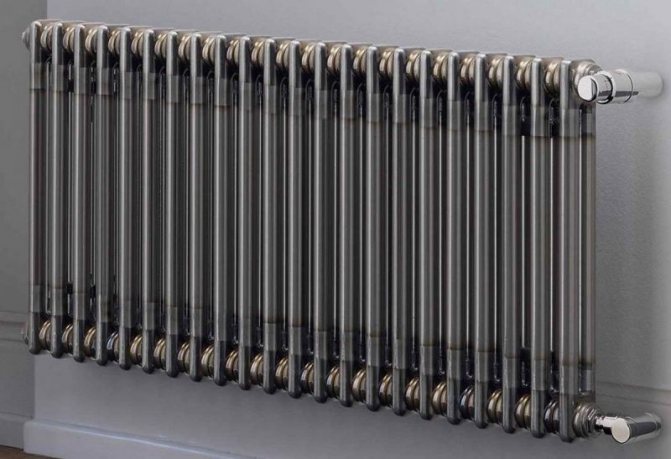

Output
In this case, we can safely say that low does not mean ineffective, rather, on the contrary, more practical and aesthetic. But it is these two qualities that are most important when a unique interior is created in a room and the question arises of how to correctly and beautifully fit batteries into it?
We hope that now you can easily solve the problem. In the video presented in this article, you will find additional information on this topic.
otoplenie-gid.ru
Installation of heating the apartment has some devices. Heating installation includes, expansion tank, collectors, boiler connection system, batteries, thermostatic pipes, air supply, fasteners, pressure increasing pumps. Each factor is of great importance. Based on this, the correspondence of each installation element must be done correctly. On this tab, we will try to define the correct structural components for the apartment.
Flat radiators
When buying a heating device, the consumer hopes for the professional advice of a consultant, and the latter, giving a recommendation, makes a comparative characteristic of various radiators, but at the same time he does not know the specific conditions in which the unit will work. Therefore, to complete the whole picture, explain to the seller everything in the smallest detail and get high-quality, professional advice from a specialist.
This unit is a register of a convective-radiation type, it has a smooth-walled branch pipe, to which metal is attached by stamping or welding, which has a different shape and improves heat transfer characteristics.
This heater transmits the thermal energy of the circulating liquid to the environment and is an independent unit, but it can also be a component of the battery.
This heater consists of at least two radiators, which form part of the mechanical connection.
Heat is removed from the heating battery in three ways: convection, radiation and heat conduction.
If heat is transferred by the movement of circulating fluid within the system and mixed with warm air in the room, then it is convection. If the surface of the battery is ribbed and its area is large, then a large amount of heat is transferred by convection. In the event that the device has a high convective characteristic, then it quickly heats up the room air, but at the same time it can create a draft and raise dust. Therefore, it is not suitable for the bedroom and nursery.
Thermal radiation - transfers internal thermal energy from a warmer body to a cooler one, while electromagnetic oscillations of different lengths are applied. They pass through the air and heat solid objects and walls located in the room, which transfer heat to the air by convection and heat conduction.
The battery shell transfers heat to the air, which, when heated, rises to the top, and cold air enters its place. Moreover, if the area of contact between metal and air is large, then the speed of movement will lead to a draft that spreads at floor level. In this embodiment, cast iron batteries are convenient.
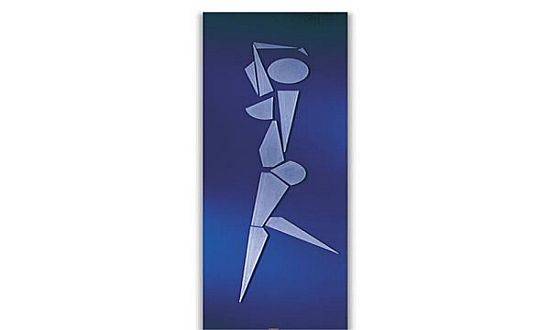

It is important! A new type of batteries has appeared on the market, which are made of cast iron or steel and are intended not only for heating, but also for decorating a room. Some European countries (France, Italy) produce flat models that are visually beautiful and can decorate a wall in a hall or living room.
There are also models for the bathroom, designed for drying towels, but some of them are antique (gold). Flat radiators are mainly made of cast iron and steel, therefore, in the article we will consider the technical characteristics of these heating devices.
They are made by casting, so there is no chance of leakage between sections. Also, such products have thickened walls and therefore the batteries are heavy with increased thermal power and, accordingly, inertness. When the system starts working with cast iron radiators, the system heats up for a long time and it also cools down for a long time.
The working pressure inside the system can be up to 15 atm. and the service life is from 40 years and more. Such batteries are resistant to corrosion, and the quality of the coolant does not affect their operation.
The disadvantage of a cast-iron radiator is considered to be a large weight, which causes a number of inconveniences during installation, and also products require periodic painting.
The first models were registers assembled from smooth pipes of various diameters. Then they were stamped from profiled sheets and joined by welding, thus forming channels (flow-through) for fluid circulation.
Modern steel radiators are made of sheets welded together, which are enclosed in a decorative steel casing that increases heat transfer. They are painted in various colors, and therefore you can choose the one that suits the interior more in shade.
Flat heating batteries are connected in pairs and so connected to the system. They have a very neat and aesthetic appearance.
The thermal conductivity of cast iron and steel is the same, but at the same time steel products have thin walls of the case and therefore the room heats up faster, and due to the formation of metal sheets, the area of contact of air with the surface of the device creates a large thermal power.
Due to the fact that these heating units are made of thin sheets (1.5 mm), they weigh a little and cool down quickly after turning off the system.
A distinctive feature is characterized by oil radiators with heating elements, tubular, sectional and panel.
Tubular radiators consist of separate vertical pipes connected to each other and having a cavity for the coolant. Moreover, they are connected by horizontal pipes, and with their help they are connected to the system. They are visually diverse and have an original look.
The service life of steel batteries is 15 to 20 years. But they have drawbacks - susceptibility to corrosion, intolerance to water hammer, their periodic painting is required.
Flat radiators heat the room well and are a work of art, for example models: Jeu de Cape (France), Danseuse (France), Greenor Rock (France), BIT (Italy), Retro (Italy) and others.
Such batteries are mainly made of steel or cast iron and do an excellent job of heating any room. In the event that you yourself cannot make the choice of the required design, then contact the consultants for help. But at the same time, describe in detail the parameters of the room where you want to install the radiator, as well as the conditions (the number of external walls, windows and the material from which the house is made), and then the choice will be made with high quality.
(No votes yet)
Flat radiators
Flat radiators are radiators that are much lighter in weight than cast iron products. These batteries have an unusual housing. They are made of steel, and in order for the thermal power to be higher, special ribs are used inside.The use of special fittings in the design of the batteries allows you to make those places that are connected to the pipes of the heating system invisible.
Flat heating battery
Flat heating radiators consist of two plates, made by stamping and welded together. There is a space (channel) between such plates - it is here that the coolant will circulate. To connect the batteries to the heating system, there are special pipes. With the help of certain types of connections, flat thin heating radiators can be formed from two or three plates.
Each plate can have convection ribs - it is thanks to such ribs that the heat transfer rate increases.
That is why the power of the device, which has ribs, will be almost 60% more. But there will also be more dust on such products, so they are placed in rooms that have high sanitary requirements.
Sectional panel heating radiator
In order to correctly classify plate heating radiators, special designations are used with numbers that are uniform for most manufacturers of such products. The first number is the number of plates, the second is the number of plates that have convection ribs:
- 10 - one plate without convection ribs.
- 11 - one plate with convection ribs.
- 21 - two plates, one of them has convection ribs.
- 33 - three plates and each has convection ribs.
The thin radiators shown above are also additionally equipped with side casings with grilles at the top. They are usually white in color.
White flat heating battery
If we talk about the standard delivery set, then it includes a set of fasteners for brick walls. If your walls are different, then you will have to buy separately all the fasteners that are required to put narrow heating radiators.
As a rule, plate radiators are made with four connecting pipes, it is they that allow you to connect radiators to the heating system from either side.
Usually, narrow heating radiators are connected either directly to the riser of the heating system, or using special fittings.
In addition, there are also such batteries that have a kit for connection with a thermostatic valve. With the help of such an insert with a thermostatic head, the speed of the water in the product is regulated. Such a kit is usually connected on the right side, however, upon special order, the manufacturer can create a battery with a kit for installation on the left side.
Flat vertical radiator with middle connection
Some manufacturers have in their assortment such narrow horizontal radiators that can be connected to the heating system in the middle - with or without a valve insert. If the radiators have an integrated kit, they will be ready to be connected to the heating system from below when the pipes are hidden under the floor. Also, special connecting elements with pipes are used, which are hidden in the wall. Such pipelines will not spoil the appearance of the room that is being heated.
When you choose the method of connecting heating radiators, you should take into account the type of system, the interior design of the room, as well as the cost of the kit from the installation.
For a standard heating system, when pipes go on the wall or in it, plate radiators with side connection are used. For systems with pipes in the floor - connection from below.
Steel plate-type radiators are used in heating systems that have forced circulation of the coolant - with pumps. Component thin radiators - in gravitational systems.
Forced circulation heating system
The hot water heating system, which will use a plate radiator, must be closed and have an expansion tank. It is not recommended to use open systems, as the radiator will then serve less time.
It is not necessary to drain the water from the system very often, because there is more oxygen in the fresh water that will be poured here. It is oxygen that leads the system to corrosive processes - not only radiators, but other elements as well. Also, experts do not recommend installing the thinnest heating radiators in rooms that have a high level of humidity, for example, in bathrooms. This will reduce the risk of corrosion.
The products are used in hot water heating systems with plastic or metal pipes; an anti-diffusion barrier must be installed to protect the system from oxygen.
Before purchasing, you should carefully study the characteristics of the home heating system. If there is a modern gas boiler with a safety valve, then the water pressure needs no more than 2.5 - 3.0 bar.
The temperature of the water in the heating system is also an important factor when choosing radiators. Simply replacing old batteries with new ones is not the right decision. It will be necessary to correctly recalculate all the parameters, taking into account the design and characteristics of the new radiators. And it is better if such work is carried out by specialists.
If you install rather powerful thin radiators, then the temperature in the rooms can be adjusted - to reduce the temperature of the heat carrier in the heating system. If batteries with low power are installed, then in conditions of extreme cold they will not be able to provide the required temperature regime.
sistema-otopleniya.ru
Positive and negative qualities
The choice of a tubular heating radiator involves, first of all, the study of all its qualities. Both advantages and disadvantages should be taken into account, only then the choice will be competent.
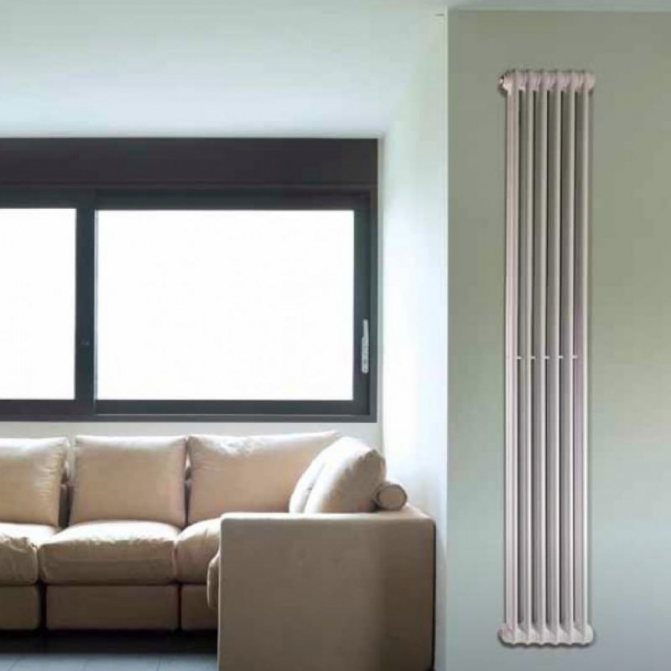

Here is what is most often attributed to the advantages of tubular options:
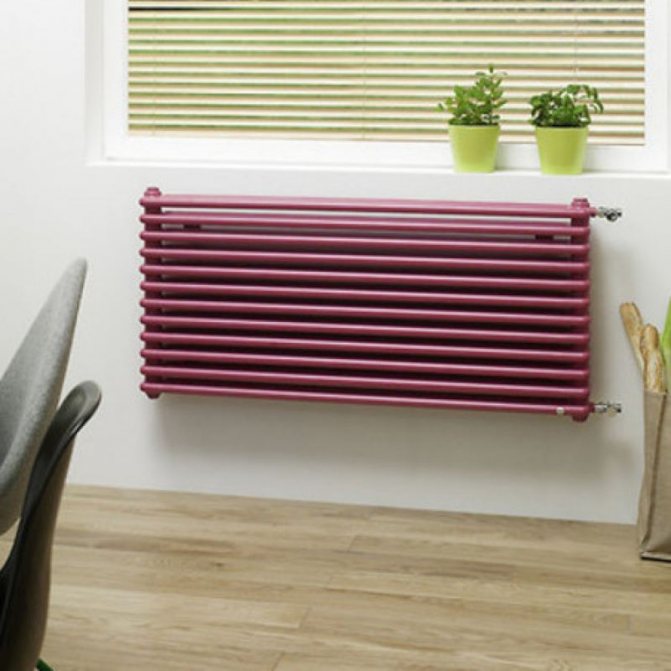

This type of radiator is resistant to corrosion and does not deteriorate when exposed to hard water.
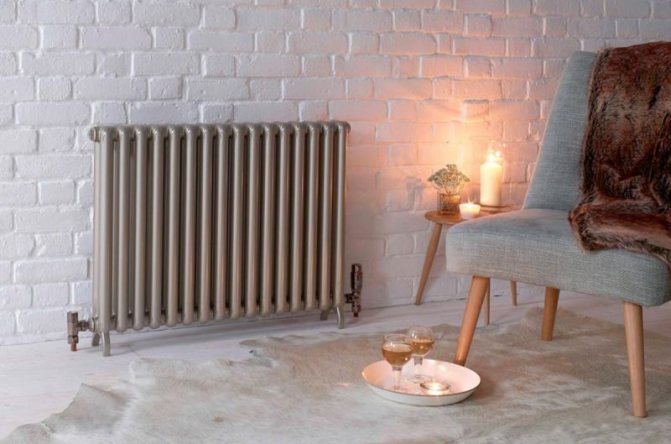

An extensive range of design solutions for the execution of Russian and foreign tubular heating radiators allows you to choose any model.

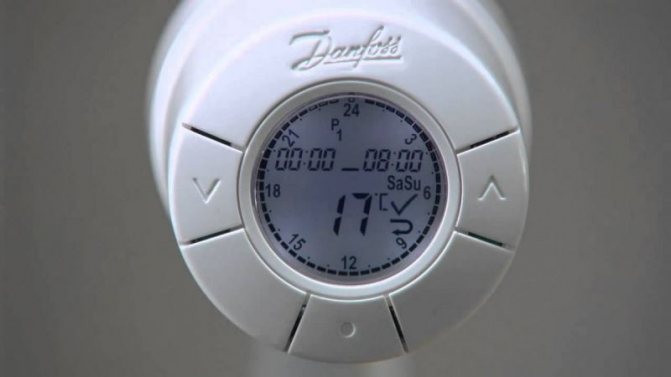
Thermostat for a heating radiator: purpose, types, device, installation in the system and tips for care and repair (video + 105 photos)
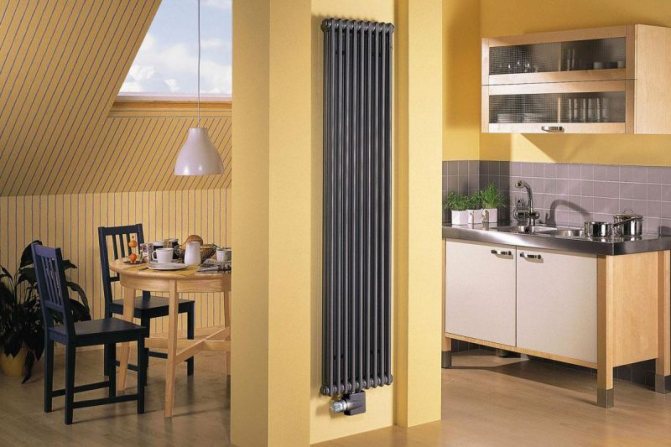
Vertical heating radiators - how to choose the ideal heating radiator and features of its application (90 photos + video)

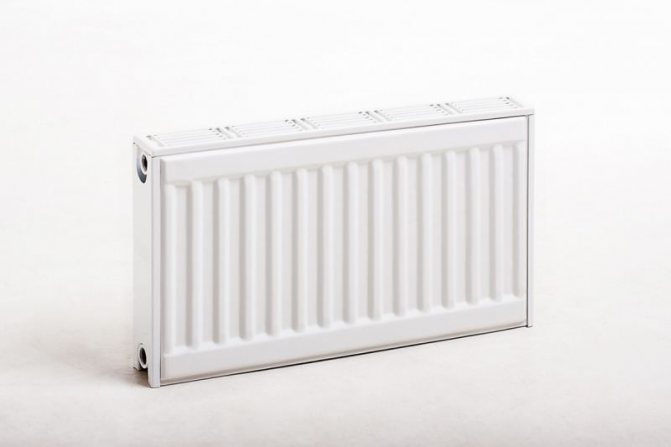
Heating radiator power: calculation of thermal power and method for calculating heating radiators (85 photos and videos)
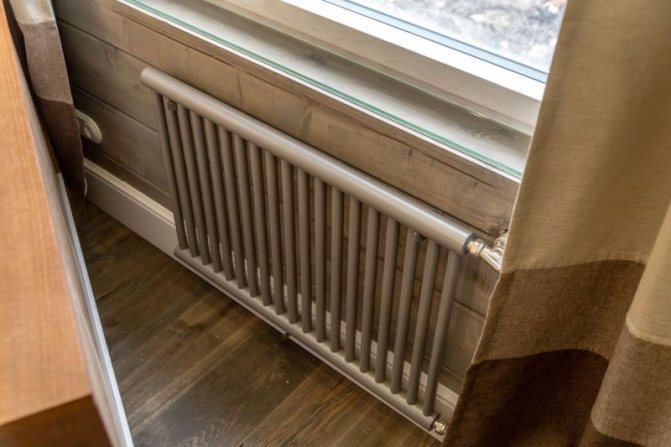

Caring for such radiators is simple, because they do not accumulate dust on themselves.
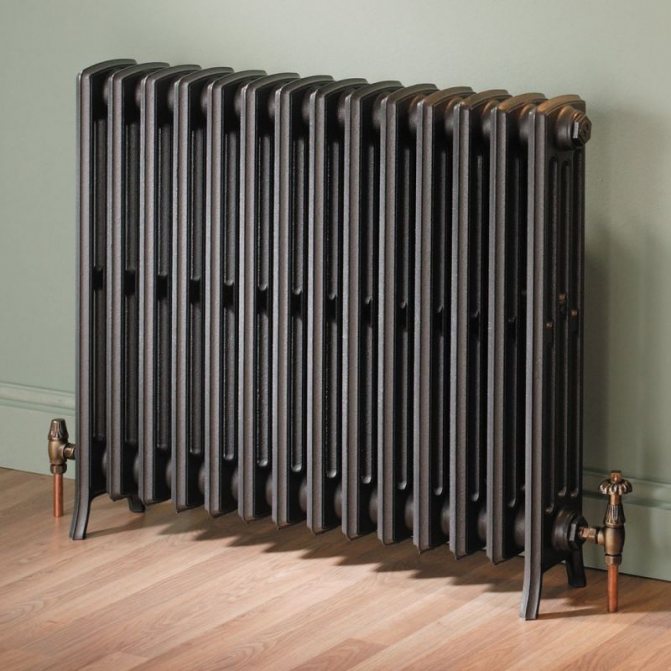

Any connection scheme will be relevant for such radiators. Tubular heating radiators can be either with bottom connection or with side connection.
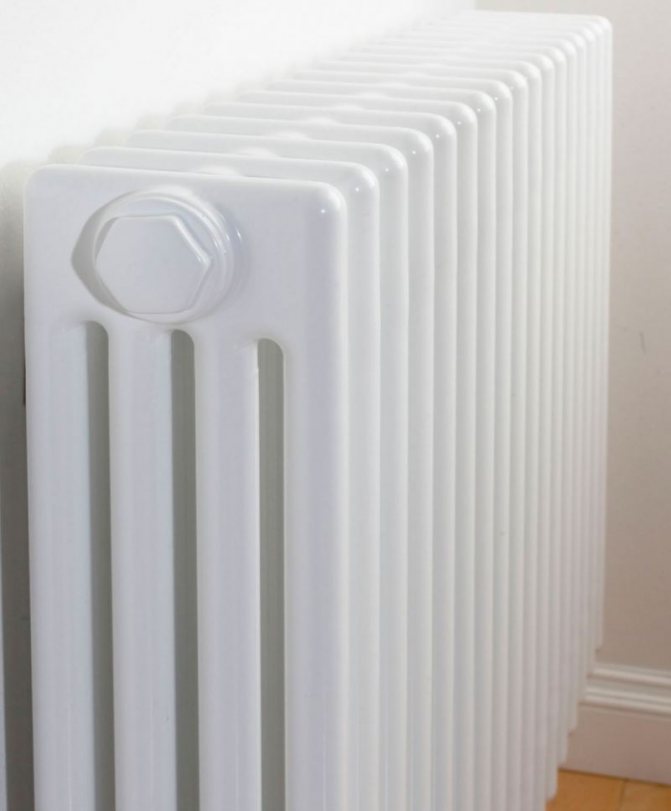

Although this variety has a lot of advantages, it cannot do without disadvantages. The most annoying thing on the list of shortcomings is the high price of tubular heating radiators.
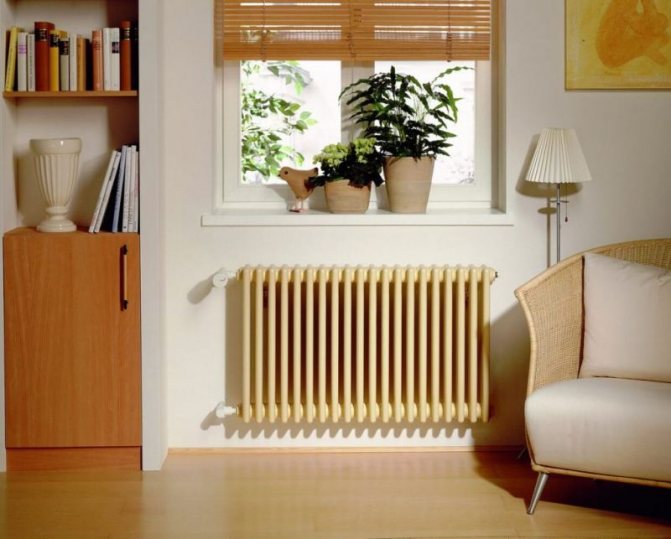

In addition, they have low power and poor heat dissipation. And also in some cases, smudges were noticed in the places where pipes were welded.
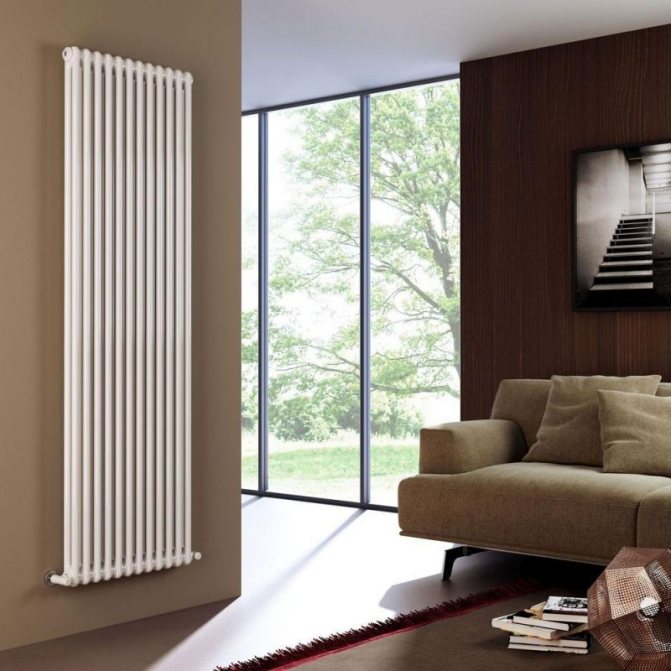

How to choose radiators and heating pipes for a private house
What are the best radiators and pipes for your home? There are many options on sale. But you need to choose what suits your private heating network best. We will understand the characteristics of these products, consider the designs, selection rules, the best solutions implemented in practice ...
Design
Modern radiators are aesthetically pleasing.Aluminum, and as their variety with steel tubes inside - bimetallic, have a similar design, divided into sections.
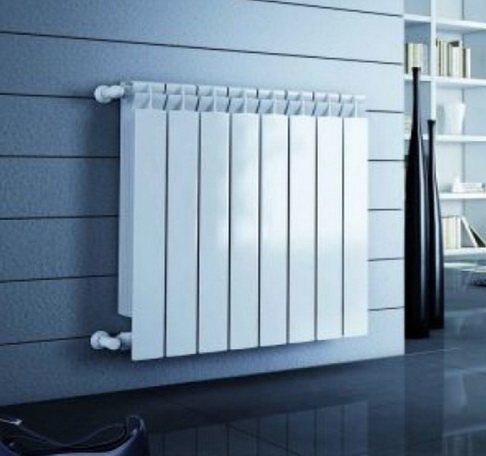

Steel without division into sections, called panel, more strict, classic look.
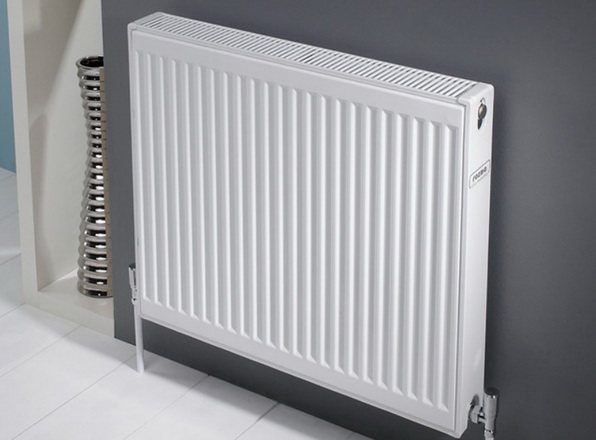

Cast iron can be artistic, with curls.
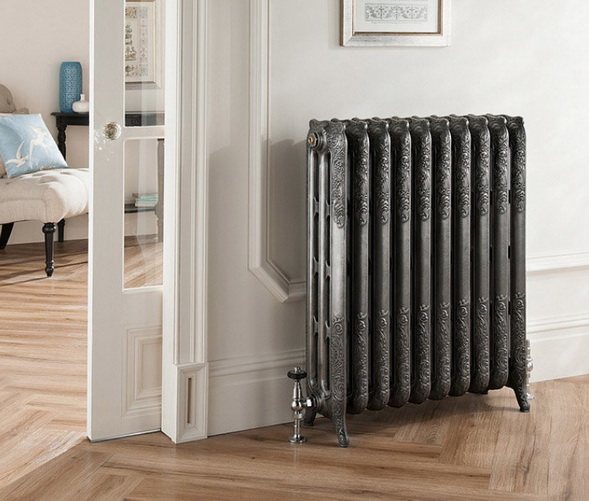

Simple cast iron with ordinary painting, as a rule, do not betray the aesthetics of the room, but they can hide behind curtains.
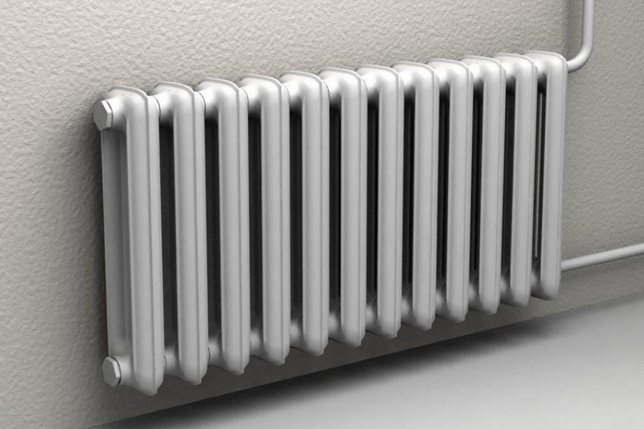

To keep it warm
Manufacturers declare about 160 - 180 W of power per section of any type of radiator, which is achieved at +90 degrees C on the supply, at a temperature in the house of +20 degrees C. C), and in the house +23 degrees C.
It is conventionally assumed that one full-size section will produce 150 watts under operating conditions. In thin versions - about 135 watts. From here, the number of sections per room is selected.
How to find out the heat loss of a room and arrange radiators
Radiators are purchased in one piece, usually in 5 or 10 sections, if necessary, they are remounted for the required power.
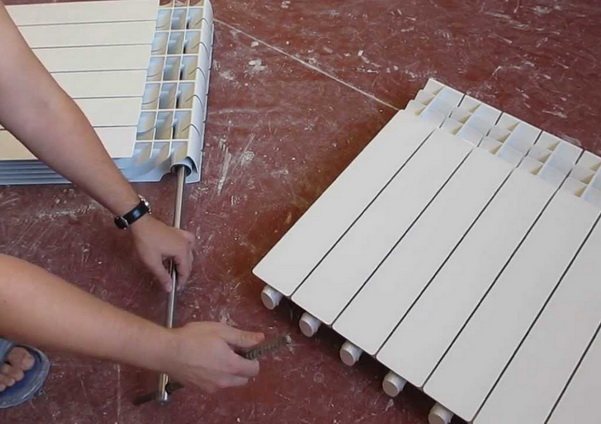

Steel panel are not divided into sections, therefore they are purchased immediately of the required size. The store will select the required parameters for the required power.
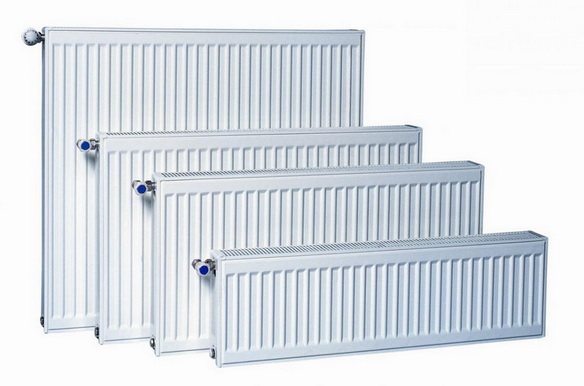

Reliability
You can often hear that bimetallic (more expensive) are more resistant to aggression and abrasiveness of the coolant than aluminum (cheaper).
But do not forget that the words "aluminum and bimetallic" are just generalizations. Each manufacturer brings something different into the design. In any case, from the inside, aluminum alloy and steel are covered with a polymer layer, which is the main guarantee of the durability of the device.
Nevertheless, usually for centralized heating networks in multi-storey buildings, where the water quality is any, and the pressure is high, manufacturers usually offer a bimetal designed for 16 atm.
And for private houses, it is recommended to save money and purchase radiators from well-known manufacturers (medium price category and above), but it is possible with a maximum pressure of 4 - 8 atm. Durability is more likely determined by guarantees and the name of the manufacturer than by conventional names - "cast iron", "steel", "aluminum" ...
How they can tell about radiators in the store
In the store, most likely from the seller, you can hear such information.
- Aluminum radiators are the softest and most pliable; among them there are no high-pressure high-rise buildings. Therefore, for a low-rise system of a private house with a safety valve pressure of up to 3 atm. such radiators will do just fine. And for apartments in multi-storey buildings - alas ...
- Steel-panel - strong and durable, but the design is not for everybody, the price is higher….
- Bimetallic ones can also work under high pressure, in them the vertical holes are reinforced with a steel pipe pressed from above with aluminum. As a rule, manufacturers give more guarantees….
- Reinforced bimetallic - without division into sections, inside a welded steel skeleton of horizontal and vertical pipes. On top of which there is all the same aluminum, so they are not distinguishable in appearance. Designed for difficult conditions in centralized heating systems….
Prices and feasibility
In the store, you can find that the cheapest are ordinary cast iron batteries. It is also known that they did not perform badly in the last century. But we must not forget that bringing such a radiator into working condition will cost one more price. They need to be dismantled, to change (as a rule) the seals between the sections. Therefore, you cannot do without the work of a locksmith. Then they need to be painted with high quality. In addition, they require a strong hitch, which is sometimes difficult to install ...
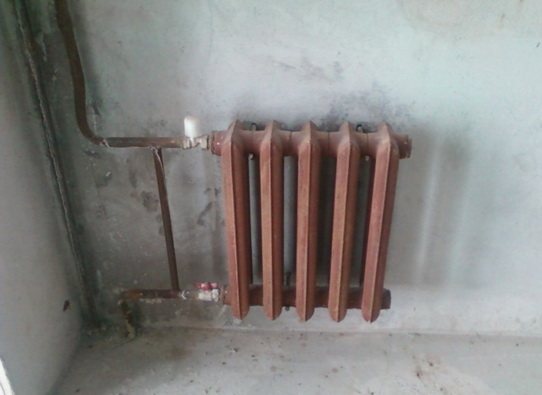

As a result, a controversial design and a graph of temperature changes over time that does not meet modern requirements - too large an intrinsic heat capacity leads to noticeable temperature jumps ...
Ordinary aluminum and steel look, as the manufacturer conceived them, are light, ready to work, designed for networks with intermittent switching on of the heating boiler.
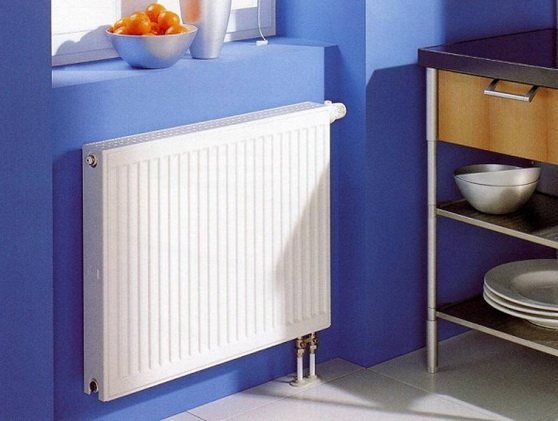

Radiators are supplied with piping
Each radiator will need a whole set of additional parts. Fastening, Mayevsky crane, one plug and two nuts for 1/2 or 3/4 inch connection, which is selected depending on the network (usually 1/2).
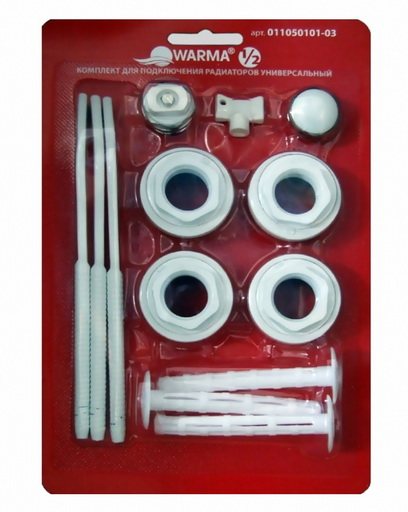

In accordance with the project, or with the idea of the heating system, shut-off valves are installed on the radiators, at least.
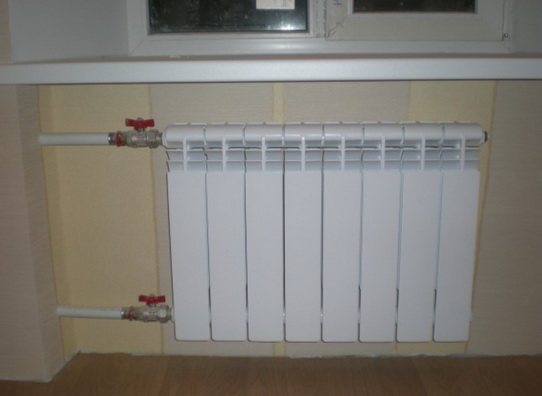

To balance the network, which is often needed, the lower (on the return) valve is changed to a balancing valve.
For automatic control of the temperature in the room according to the set value or for operational manual change (shutdown of the room, for example), only with automated boilers, valves controlled by thermal heads are used, installed at the top of the supply.
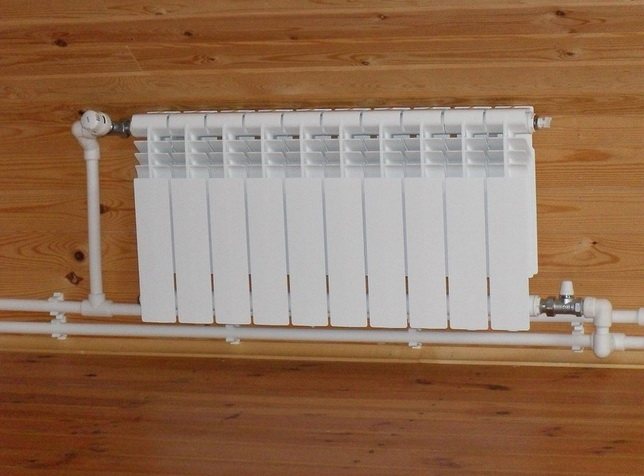

Choice of radiators with bottom connection
Recent trends in construction are aimed at freeing room design from heating appliances. The usual solution is to hide the pipes under the floor. Special radiators with bottom connection are becoming relevant. Their use, as a rule, is provided for in the project, where the floor structure and the possibility of placing heating pipes in it are also determined.
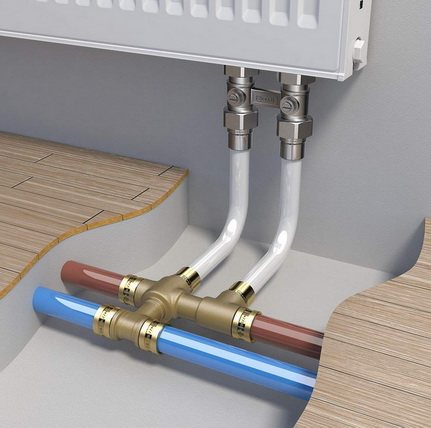

Option for connecting floor convectors with pipes under the floor - more ...
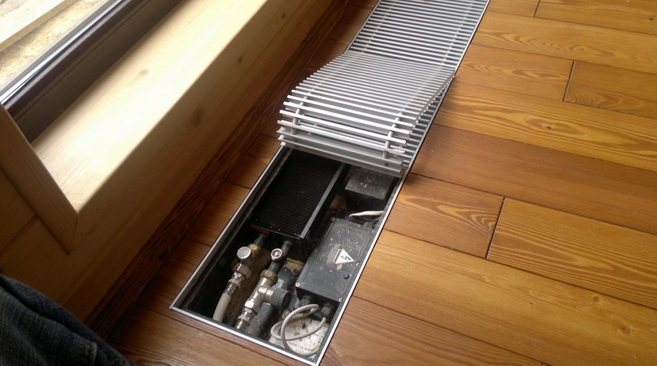

Pipes to radiators
In a private house, you can use various pipes for heating. Polypropylene from home craftsmen are high in the rating because they are the cheapest along with their fittings, and weld them together with a polyfuse is a piece of cake.
But for professionals, these pipes are far from being a priority. Because with them it is impossible to guarantee anything to the customer - the quality of welded joints cannot be controlled.
If you cut the welded joint of such pipes, you can see how the internal section or the prospect of leaks in a year or two is melted, and this is not uncommon due to the basal quality - to one degree or another it will be present in any installer.
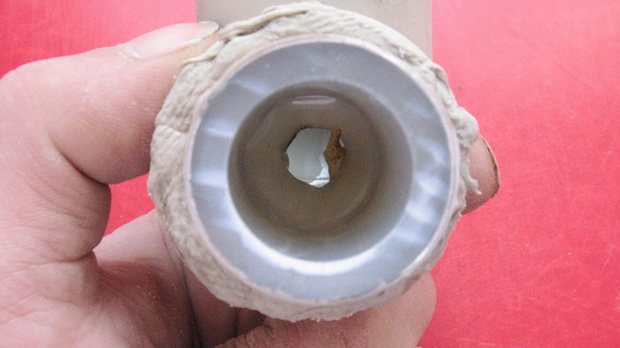

Therefore, more often, in serious systems, metal-plastic pipes are used, as the best solution of all polymer options (PEX, PERT) for oxygen barrier, for thermal expansion, and providing high-quality controlled joints.
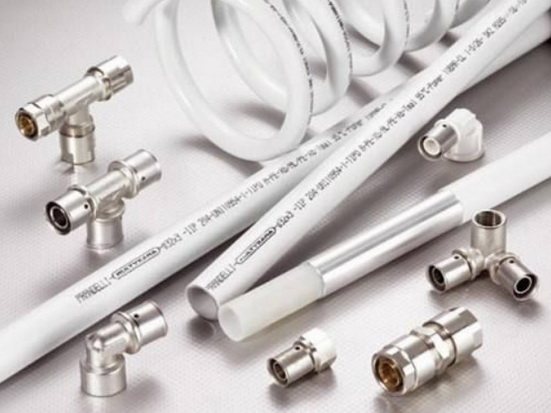

Copper, stainless steel - more expensive, made to order for the aesthetics of the premises, but rather a design technique ...
How are pipes made of metal-plastic
The most popular among professionals are metal-plastic pipes. With a special tool, crimping pliers, you can install crimping fittings, which are considered very reliable and form a non-dismountable connection. But for home installation, you can use collet (compression) fittings. For the installation of which you need only scissors, a calibrator and a wrench.
- It is important to cut the pipe to the required length with high quality, without burrs and perpendicularly.
- It is also important to carefully calibrate it and then remove the inner chamfer.
- A nut and a collet are put on the pipe, the pipe is pushed onto the fitting seals so that the seals remain in place (you can lubricate with soap ...), then the nut is screwed onto the fitting first with your hands, then with a wrench, so that a couple of threads remain, squeezing the joint. When properly assembled, the connection does not leak, tightening is not required.
How best to apply radiators and pipes
The arrangement of radiators under the windows is a common scheme, the most rational in terms of ensuring high-quality heating of rooms, in which thermal curtains are created in cold zones. Radiators are installed horizontally (hung on the brackets for attaching to the walls), connected to the system so that the coolant moves diagonally through them. The ones connected from below have their own internal wiring diagram.
Low-standard radiators can be used under high windows.
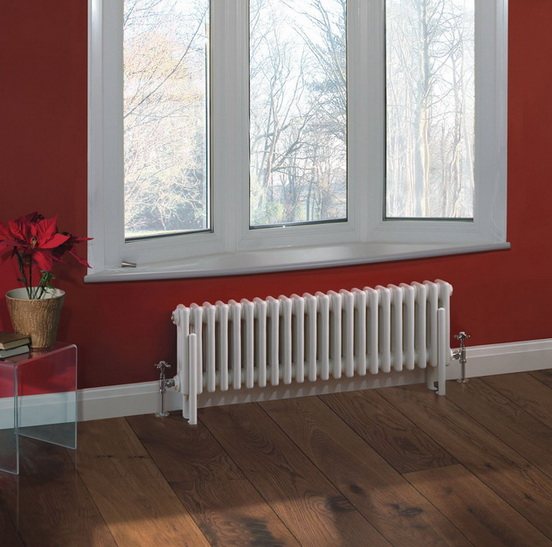

It is also possible to install floor convectors, which are selected according to their power, are connected and tied in the same way as radiators. Why floor convectors are used….
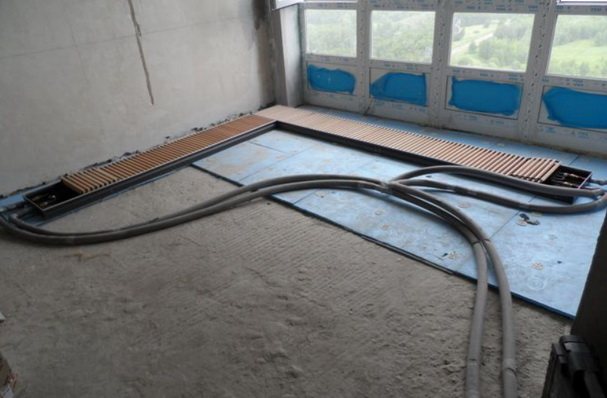

An advanced solution is the laying of flexible metal-plastic pipes under the floor in a heat-insulating casing. In addition to design requirements, this reduces pipe length, reduces the number of fittings, and there are no obstacles to the application of wiring diagrams. Often combined with underfloor heating.
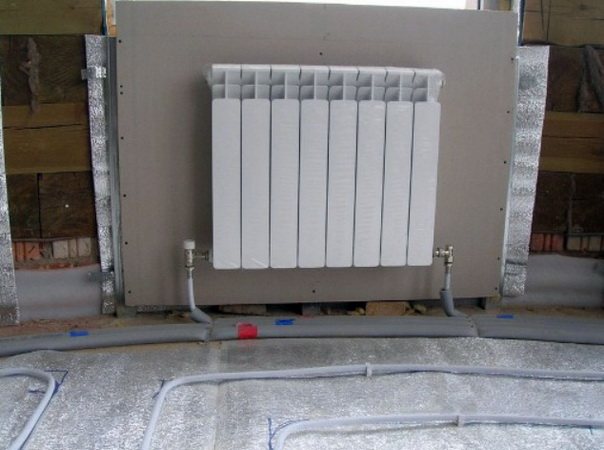

It is even possible to lay the heating pipeline in the casing-plinth.
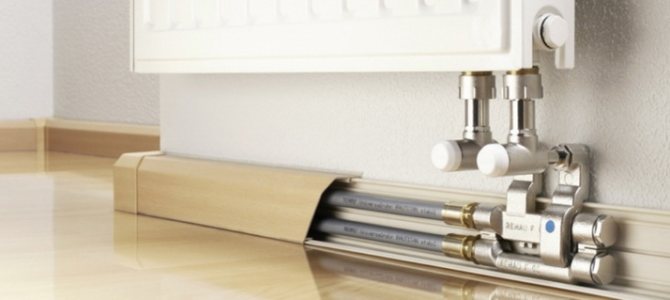

You can see how the associated heating system is made
Photo of tubular heating radiators
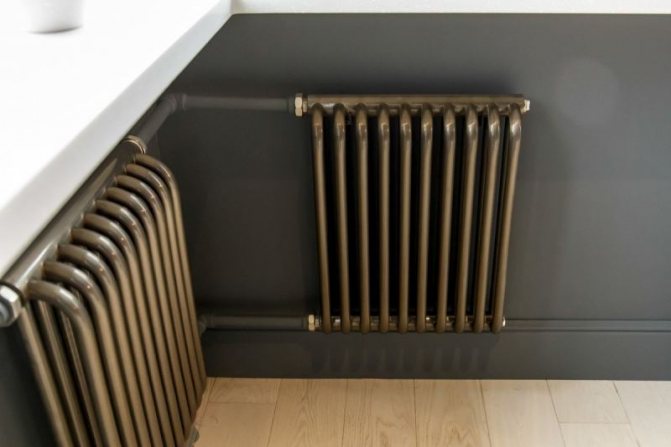


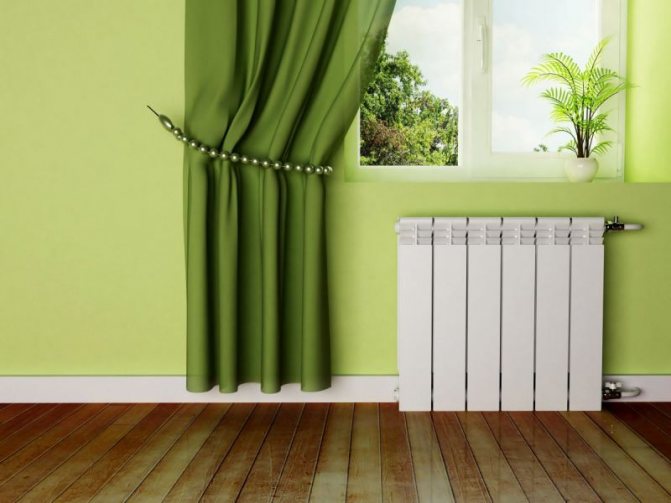
Heating radiator piping - connection diagrams and options for choosing a connection method (drawings + 90 photos)
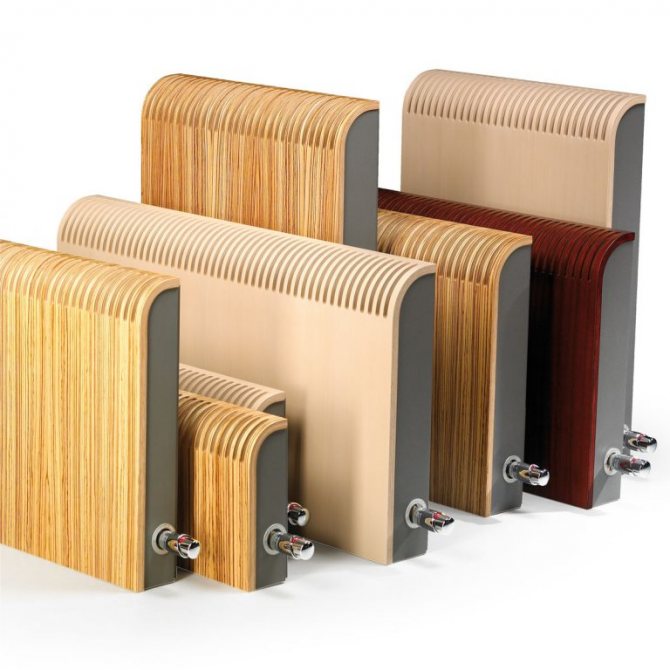
Water heating convectors: pros, cons and types of convectors. Expert advice on the selection and use of water convectors (135 photos and videos)

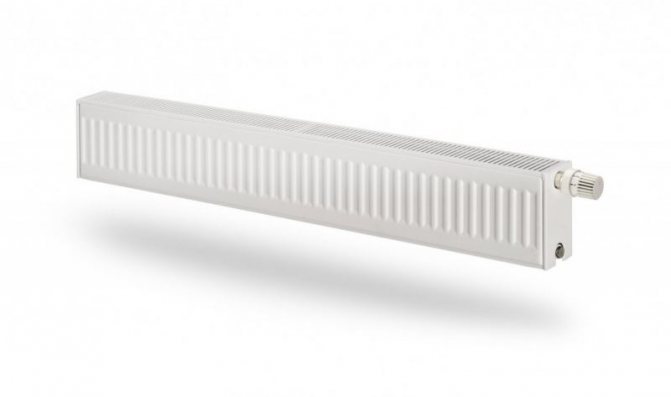
Which heating radiators are better: an overview of the best models for an apartment and a private house (115 photos)
Did you like the article? Share


0
1
Vertical batteries
Models with a vertical orientation are much less common, and are most often available in stores only to order. This is due to the fact that such products are mainly used to create unusual interiors.
From a technical point of view, vertical orientation is disadvantageous, since heated air is located at the top, which reduces the rate of heat transfer. Convection activity also decreases, warm masses accumulate under the ceiling.
The artistic value of batteries with a vertical installation does not cause any doubts: they are often indispensable, especially in rooms with columns, high windows on the entire wall, a large number of openings and niches in the walls.
However, such interiors are found only in wealthy houses, so the price of vertical models is high, and the popularity among the masses is low.
Important! Vertically oriented heaters most often solve purely artistic tasks and are not widely used.
Choosing a location
The good thing about batteries with a minimum depth is that they can be installed in almost any free space. The set of such radiators, in addition to fastening tools and accessories, includes wheels for movement and attachment to them. Therefore, if heating is needed in another place, the heating devices can be easily removed from the wall and put on these wheels in any corner of the room.
For example, tubular radiators are more suitable for the bathroom. And into the living room - ribbed plates.
Design advantages and disadvantages
Such solutions are now becoming more and more popular among consumers due to many obvious advantages:
- Modern heating devices of this type are aesthetically pleasing;
- They have a relatively high efficiency;
- With the correct connection, the sections warm up very evenly and quickly;
- They have a long service life;
- Fast warm-up provides excellent interaction with regulatory systems - if you are going to install an electronic thermostat in your house, then a temperature-responsive steel radiator is the best choice;
- These devices are much lighter than other heating options, especially cast iron, they are easy to transport and install.
Relative disadvantages include the rather high price of this type of heating device and the exacting quality of production. If you want the battery to work for a long time, buy models from trusted brands. The warranty period for most manufacturers is 5 years. The guarantee of radiators from the Finnish company PURMO, which our store sells, is 10 years.
Our company offers to purchase high quality heating devices.You can buy a tubular steel radiator from us, made at the best factory in Europe, a high-quality and efficient product that will warm your home, bringing warmth and comfort for many years.

